





Duel between CSS Alabama and USS Kearsarge by Edward D. Walker. Buy the print.
Off Cherbourg, France in 1864, two old shipmates squared off in the greatest maritime clash of the Civil War
|
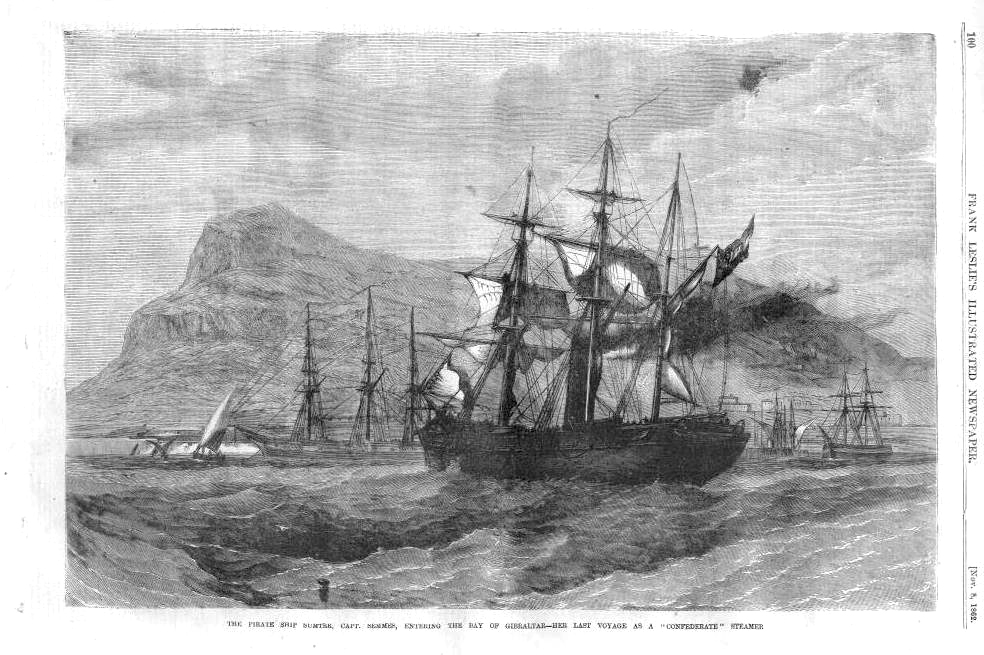
“The pirate ship Sumter, Capt. Semmes, entering the Bay of Gibraltar—her last voyage as a ‘Confederate’ steamer.” As sails gave way to steam and paddle side-wheels to screw propellers, warfare at sea no longer depended on the whims of wind or current, but still on those of landlubber politicians. Even lying at anchor in a foreign harbor, Cmdr. Raphael Semmes of the Confederate States Navy had been perfectly outmaneuvered. His bark-rigged screw steamer, CSS Sumter, had spent the latter half of 1861 as the first Confederate high-seas commerce raider, capturing or sinking 18 Union ships from Cuba to Brazil. But she had spent the first months of 1862 in the British port at Gibraltar, blockaded by Federal warships more securely than had she sheltered at Charleston or Mobile. 
Cdr. Raphael Semmes and the officers of CSS Sumter. Semmes (known to his crew as “Old Beeswax” for his finely tipped moustaches) and the Sumter had twice before escaped Union blockades, beating the USS Brooklyn from New Orleans in June 1861 and the USS Iroquois from Martinique in November. At Gibraltar, however, he’d been checkmated. “If a neutral merchant showed any inclination to supply the Sumter with anything she needed,” Semmes wrote in his memoirs, “...a runner was forthwith sent round to him by the [US] Federal Consul, to threaten him with the loss of his American—i.e. Yankee—trade, unless he desisted. Such was the game now being played in Gibraltar, to prevent the Sumter from coaling.... I resolved to lay her up, and proceed to London, and consult with my Government as to my future course.” 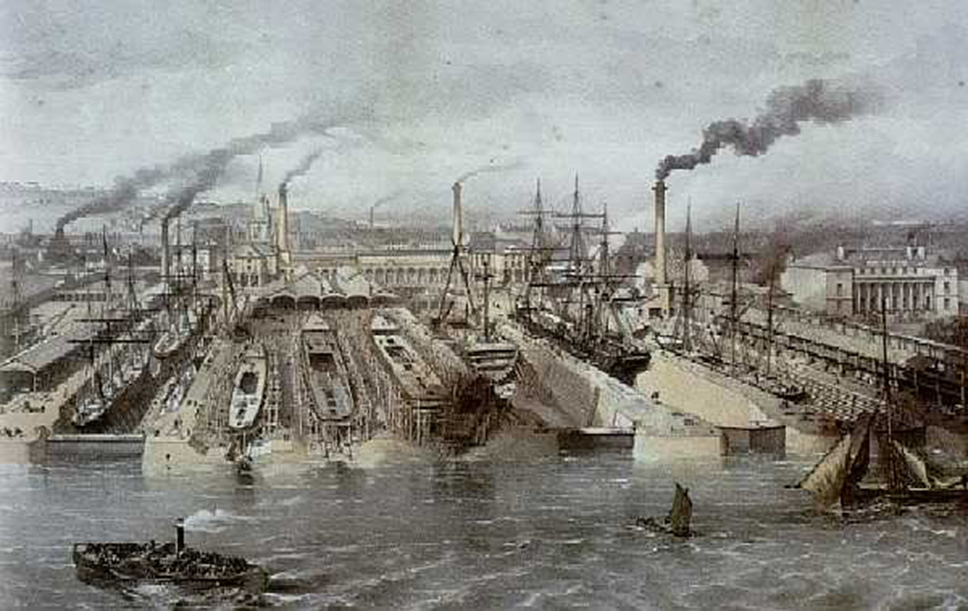
The Laird shipyard on the Mersey River, across from Liverpool, around the time of the Alabama’s construction. In England Semmes and his executive officer, Lt. John Kell, learned from Confederate Commissioner James Murray Mason of a new ship being built on the Mersey River near Liverpool. Confederate foreign agent Cmdr. James Bulloch had covertly financed her construction, through the sale of Southern cotton, as “Hull 290.” She would be an all-wood, bark-rigged (foremasts rigged square, mizzenmast fore-and-aft), 220-foot sloop of 1050 tons displacement. Two 300hp steam engines driving a single two-bladed propeller would give her 13 knots. Much as Semmes admired her, though, she was Bulloch’s ship. Semmes was on his way home when he received word from Stephen Mallory, Secretary of the Confederate States Navy, that Bulloch was more useful on land than at sea, and Semmes was to “...assume command of the new ship which was being built on the Mersey, to be called the Alabama.” 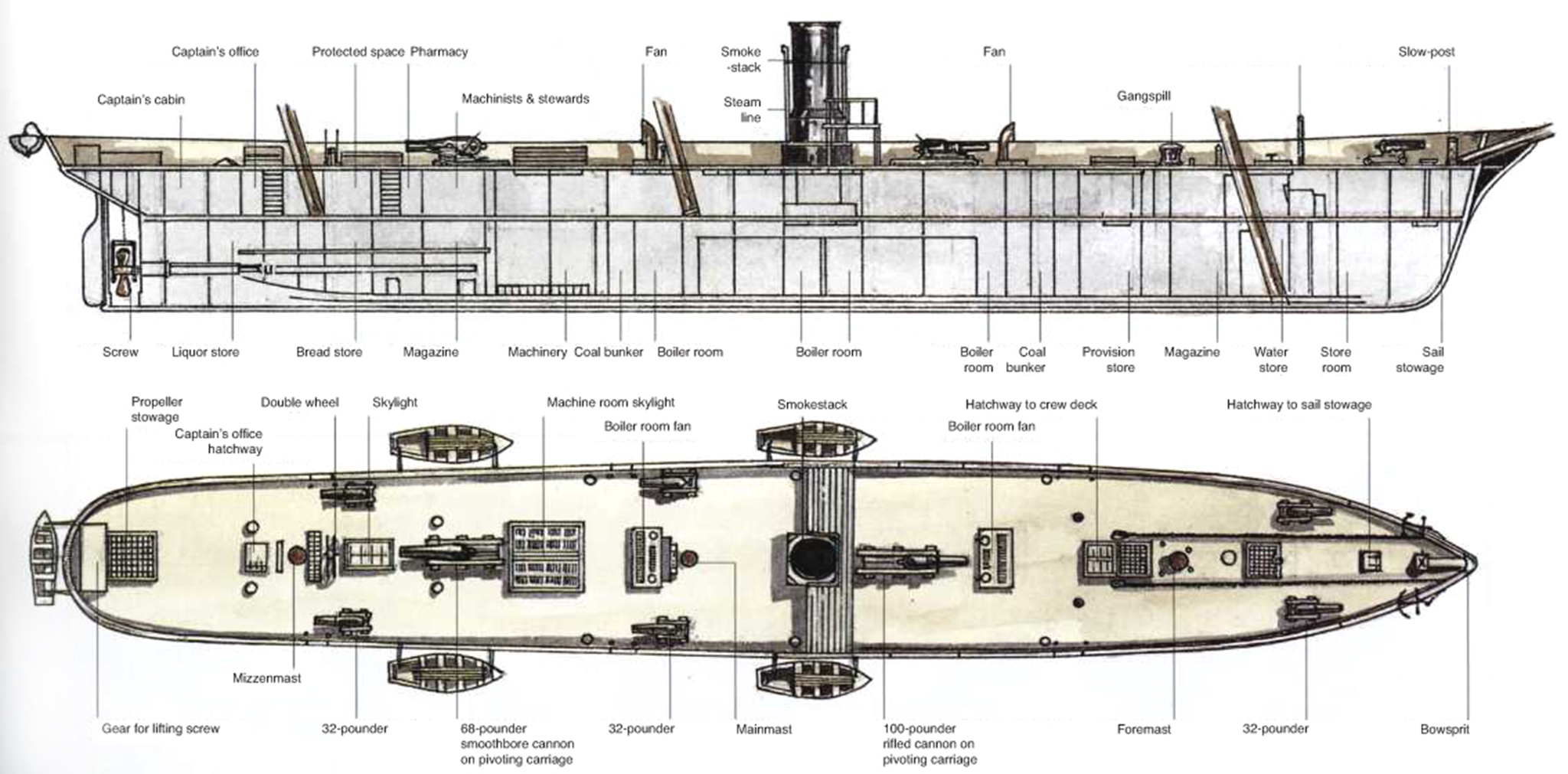
Plan of CSS Alabama, including pivot gun mounts 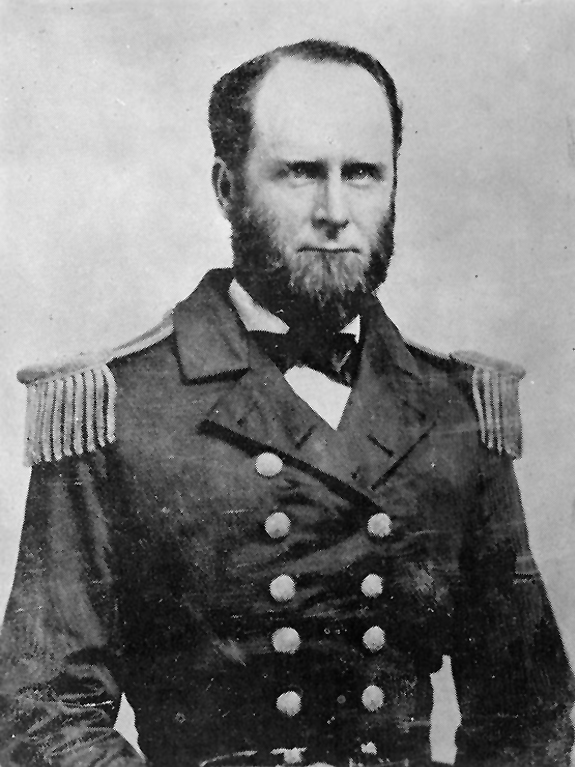
Lt. John M. Kell of the Alabama “She was a perfect steamer and a perfect sailing ship, at the same time,” marveled Semmes. “...The Sumter, when her fuel was exhausted, was little better than a log on the water, because of her inability to hoist her propeller, which she was, in consequence, compelled to drag after her. The Alabama was so constructed, that in fifteen minutes, her propeller could be detached from the shaft, and lifted in a well contrived for the purpose, sufficiently high out of the water, not to be an impediment to her speed. When this was done, and her sails spread, she was, to all intents and purposes, a sailing ship. On the other hand, when I desired to use her as a steamer, I had only to start the fires, lower the propeller, and if the wind was adverse, brace her yards to the wind, and the conversion was complete.” British law forbade English citizens from equipping or manning warships for foreign belligerents; alleging that Hull 290 (launched on May 15th as the HMS Enrica) was to be a Confederate warship, Ambassador Adams convinced British Foreign Secretary Earl John Russell to impound her. “It will, doubtless, be a matter of some delicacy, and tact, to get the Alabama safely out of British waters, without suspicion,” wrote Semmes, “as Mr. [Charles Francis] Adams, the Northern Envoy [US ambassador to England], and his numerous satellites in the shape of consuls and paid agents, are exceedingly vigilant in their espionage.” 
The Enrica raises steam on the Mersey. By Edward D. Walker Customs officials were on their way to Liverpool when Enrica, still unfinished and hosting a luncheon party of civilians, ladies, and friends of the builders, weighed anchor for what was to be a brief river cruise. Had she returned to port she would have been embargoed. Instead she put her guests off on a harbor tug, raised steam, and took off—supposedly—for Nassau, Bahamas. But Semmes and Bullock actually redezvoused with her at Terceira Island in the Azores, where Enrica stood taking aboard a full armament of cannons from the tender CSS Agrippina. In contrast to the old Napoleonic-era men-of-war, firing broadsides of sometimes over 100 guns, Alabama mounted just eight. Her six 6.4-inch, 32-pound smoothbores would have served as the main armament of Lord Nelson’s HMS Victory just 60 years earlier, but they were dwarfed by Alabama’s main guns. These numbered just two, designed by Captain Theophilus Alexander Blakely of the British Army, arms merchant to the CSA. With cast iron barrels and breeches wrapped in wrought iron or steel bands, they were so heavy they had to be mounted directly amidships for proper sea-keeping, manhandled on a complex system of pivots and tracks to one side or the other and locked down prior to battle. The aft 8-inch smoothbore fired a 68lb shot or 42lb shell; the forward 7-inch rifle fired a longer 100lb shot or 85lb shell. 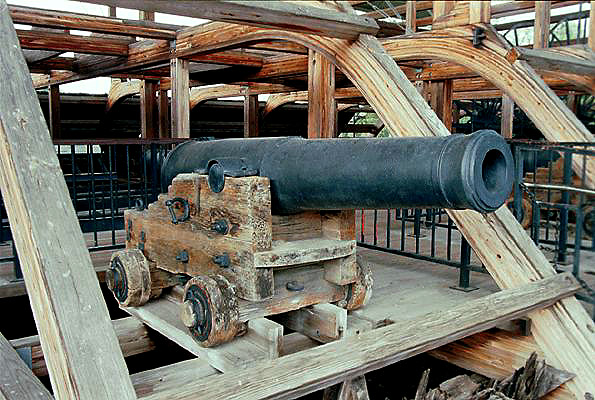
32-Pounder Smoothbore 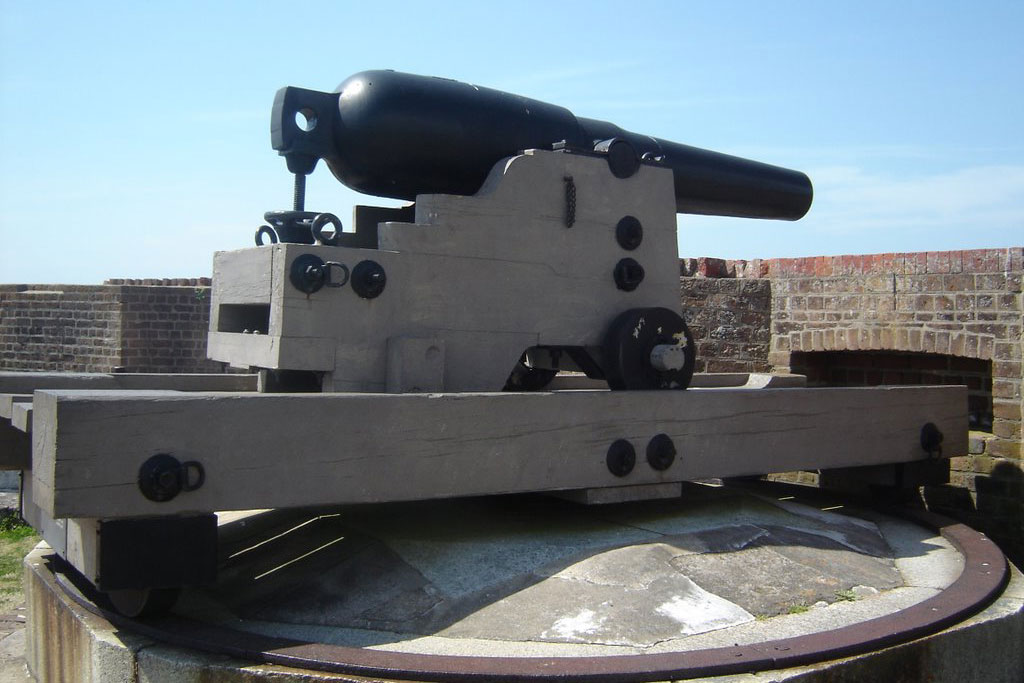
Rifled Blakely Pivot Gun 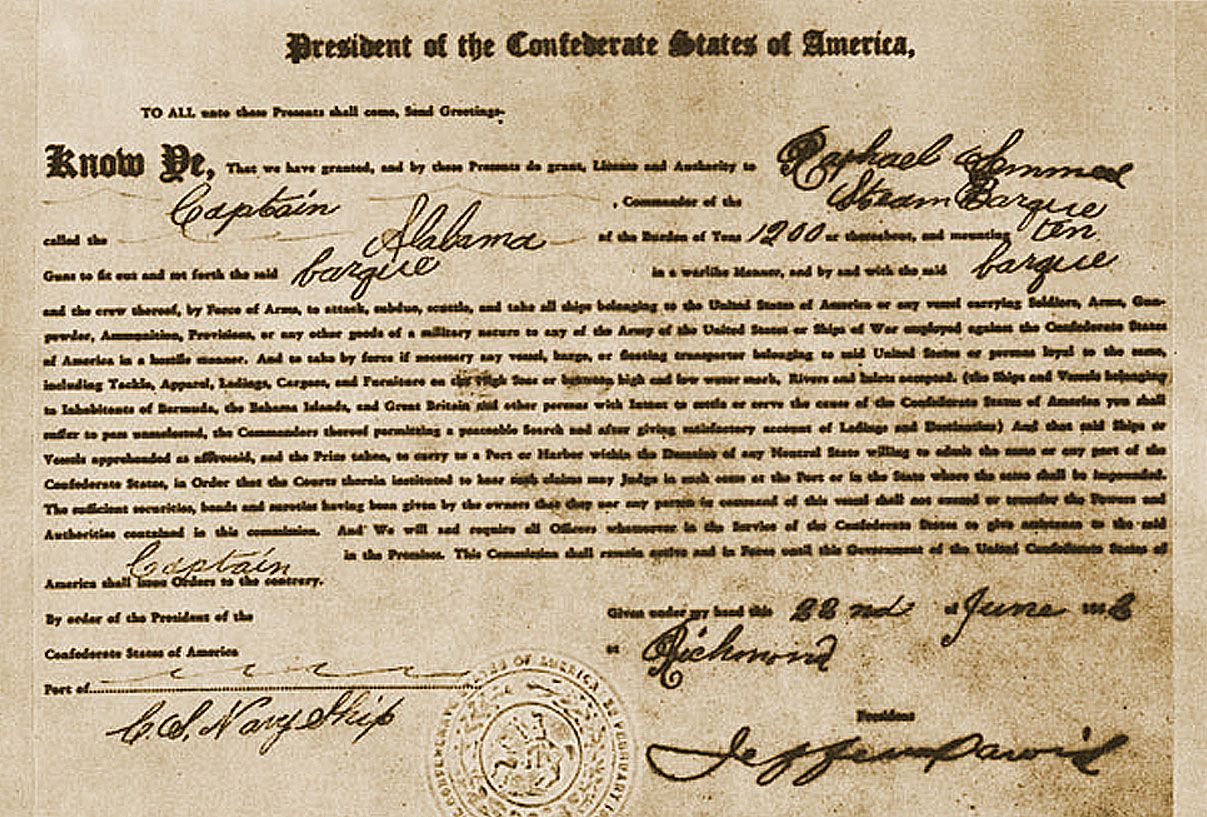
Semmes’ commission as Captain of CSS Alabama with orders to “attack, subdue, scuttle and take all ships of the United States of America” On Sunday, August 24th, newly promoted Captain Semmes called his largely English crew to the quarterdeck. A band played “Dixie” as he read aloud his commission from Jefferson Davis, President, CSA, Enrica's Union Jack was lowered and and the Alabama’s Stars and Bars were run up. “Now, my lads, there is the ship. She is as fine a vessel as ever floated; there is a chance that seldom offers itself to a British seaman, that is, to make a little money,” he told them. “We are going to burn, sink and destroy the commerce of the United States. Your prize money will be divided proportionately.... Any of you that thinks he cannot stand to his gun, I do not want.” Lt. Kell signed eighty hands to join the Sumter veterans. “The Alabama will be a fine ship, quite equal to encounter any of the enemy’s steam-sloops,” their captain logged, “...and I shall feel much more independent in her, upon the high seas, than I did in the little Sumter.” 
The Alabama in the North Atlantic 

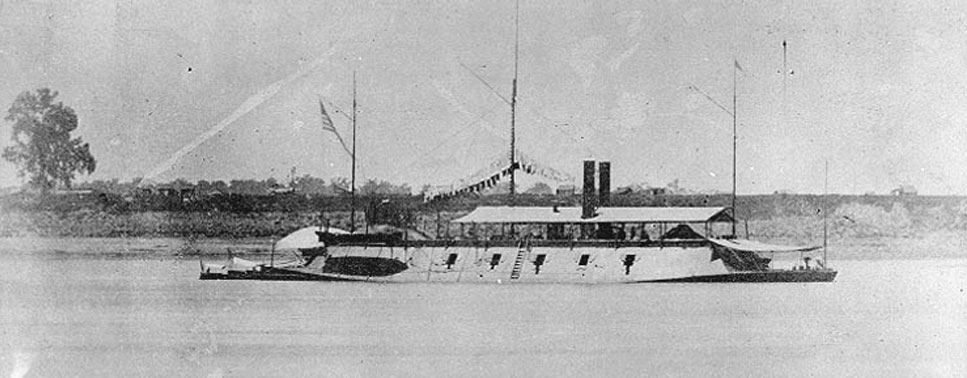
USS Benton off Natchez, Mississippi, July 1864 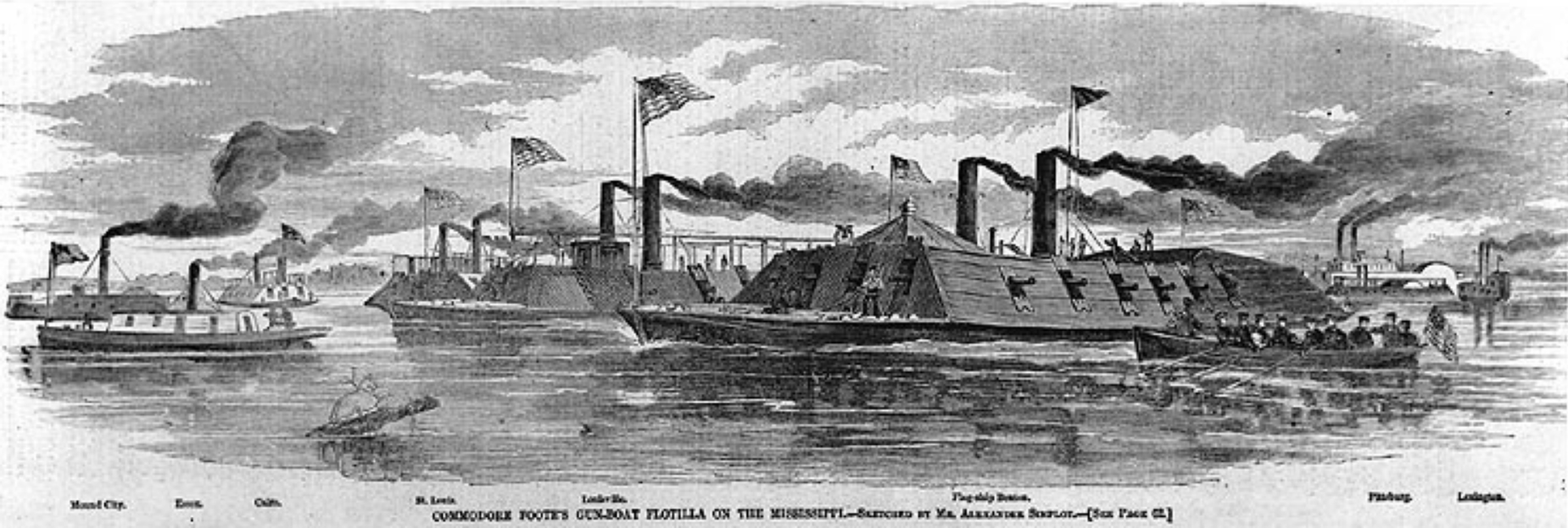
“Commodore Foote's Gun-boat Flotilla on the Mississippi” While Semmes steamed off to seek glory, an old friend of his was languishing in the backwaters of the naval war. In 1861 Commander John A. Winslow, USN, had been assigned to the Western Gunboat Flotilla at Cincinnati, intended to sail down the Ohio and wrest control of the Mississippi. He had not been confident of the outcome: “Our [ironclad] gunboats are heavy, some fifteen or sixteen guns, 8 inch, and 9 inch, and 42 pound rifle guns, but it is doubtful whether we can get down the river, on account of the draft of water, without first taking out the guns.” On his first venture downstream in command of the flagship Benton, she grounded on a sandbar 30 miles south of St. Louis. As Winslow attempted to winch her off, a link of 1½-inch chain parted with such force that one shard flew 500 feet; another struck him in the left arm, tearing away much of the muscle. “It was a great mercy that the bolt did not strike me on the body,” he wrote home, “as it would have made an end of me.” Sent home to Roxbury, Mass., to recuperate, he did not return to duty until the summer of 1862. He was promoted to captain in July and might even have expected command of the flotilla, but he was passed over, possibly due to his increasingly dim view of superiors up to and including President Abraham Lincoln. After the Union defeat at Second Bull Run that August, Winslow (who had been born and raised in Wilmington, NC) told a reporter for the Baltimore American, “I’m glad of it. I wish the Rebs would bag Old Abe, too.... Until something drastic is done to arouse Washington we shall have no fixed policy.” Secretary of the Navy Gideon Welles narrowly declined to prosecute Winslow for insubordination or even treason, but at the end of October wrote him, “You are hereby detached from the Mississippi Squadron and placed on furlough.... You will regard yourself as awaiting orders.” Home again in Massachusetts, Winslow surely felt his punishment weighing on him. He was bedridden with Mississippi malaria and an inflammation of his right eye (of which he would eventually lose sight) when Welles found a suitably out-of-the-way posting for him: command of the USS Kearsarge, which under Capt. Charles W. Pickering had failed to do more than corner the slow little Sumter. (That same month Sumter was sold to the British, and under the Union Jack eventually resumed service to the Confederacy as the blockade-runner Gibraltar.)


In 1846, as young lieutenants during the Mexican War, each had assumed his first command. Winslow took over a captured Mexican sloop renamed the USS Morris, and Semmes the brig USS Somers (infamous for an 1842 midshipmen’s mutiny under captain Alexander Slidell Mackenzie, which led directly to the founding of the US Naval Academy and may have served as inspiration for Melville’s Billy Budd). Each, however, lost their ships: the Morris on a reef in a storm, and the Somers, while chasing a Mexican blockade-runner, capsized in a sudden squall. Both officers were completely exonerated of the losses, but spent time together in the doghouse aboard the American flagship, Cumberland (later the first ship sunk by the Confederate ironclad CSS Virginia). “It is a joke now,” Winslow wrote, “...so I frequently say, ‘Captain Semmes, they are going to send you out to learn to take care of ships in blockade,’ to which he replies, ‘Captain Winslow, they are going to send you out to learn the bearing of reefs.’” Both lieutenants were promoted to commander in 1855. In December 1860 Winslow’s appointment as Inspector of the 2nd Lighthouse District was signed by Semmes, as Secretary of the US Navy Lighthouse Board. The next month, however, when the country sundered, the old friends took opposite sides. 
USS San Jacinto in the North Atlantic Built to experiment with new propulsion concepts, the San Jacinto was plagued with prop trouble and mechanical failures throughout her service, but became infamous in November 1861 when her Capt. Charles Wilkes waylaid the British mail packet HMS Trent. Firing two shots across the bow to persuade the British to heave to, Wilkes sent a boarding party to illegally seize two Confederate diplomats and their secretaries before permitting the packet to be on her way. Little over a year later, the Federals hoped to bully the Alabama in the same manner. In December 1862 Winslow shipped out from New York aboard the 3,360-ton ex-passenger steamer USS Vanderbilt (which, despite her side wheels, mounted twelve 9-inch smoothbores and two 12-inch rifles and, able to do 14 knots, was probably the US Navy ship most feared by Semmes) for his rendezvous in the Azores with the Kearsarge. Meanwhile, Semmes and the Alabama rendezvoused with the Agrippina in Fort Royal, Martinique, where they were nearly bottled up by the USS San Jacinto. This screw frigate, mounting eleven big guns, could throw twice the Alabama’s weight of shot, but Semmes was unimpressed. “We paid no sort of attention to the arrival of this old wagon of a ship,” he wrote. “She was too heavy for me to think of engaging her...but we had the speed of her, and could, of course, go to sea whenever we pleased.” On the rainy night of Nov. 19th the Alabama made good on his brag, slipping past in the dark. Not until the 21st were the Federals even sure she was gone. On December 7th, the day Winslow entrained for New York and the Azores, Alabama lay in wait for “California steamers” transiting the Windward Passage between Cuba and Hispaniola, from New York to Panama for West Coast gold. She ran down the side-wheel steamer Ariel, owned by no less than Cornelius Vanderbilt himself, carrying 140 US Marines with all their gear. Semmes reaped 124 muskets, 16 swords and $10,000 in Federal cash—Alabama’s largest single haul of the war—and released the ship under a $261,000 bond (worth $6.3 million today) payable on demand when the Confederacy won the war. Even more importantly, Ariel’s cache of New York newspapers, less than a week old, announced that a 30,000-strong army under Gen. Nathaniel P. Banks was embarking for a likely invasion of Texas, at Galveston. “To transport such an army, a large number of transport ships would be required,” Semmes reasoned. “...As there were but twelve feet of water on the Galveston bar, very few of these transport ships would be able to enter the harbor; the great mass of them, numbering, perhaps, a hundred and more, would be obliged to anchor, pell-mell, in the open sea. Much disorder, and confusion would necessarily attend the landing of so many troops, encumbered by horses, artillery, baggage-wagons, and stores. My design was to surprise this fleet by a night-attack, and if possible destroy it, or at least greatly cripple it. Half an hour would suffice for my purpose of setting fire to the fleet, and it would take the [Union] gun-boats half an hour to get up steam, and their anchors, and pursue me.” His information wasn’t quite fresh enough, however. On New Years Day the Texans under Maj. Gen. J. Bankhead Magruder counterattacked and repelled the invaders. By the time the Alabama arrived, at dusk on the 11th, lookouts perceived no enemy armada (the main force of troops having disembarked at New Orleans instead), but merely a half-dozen warships, maintaining a sullen blockade. 
The Battle of Galveston 
The USS Harriet Lane, center, being attacked by the CSS Bayou City and CSS Neptune at the Battle of Galveston. (U.S. Naval Historical Institute) 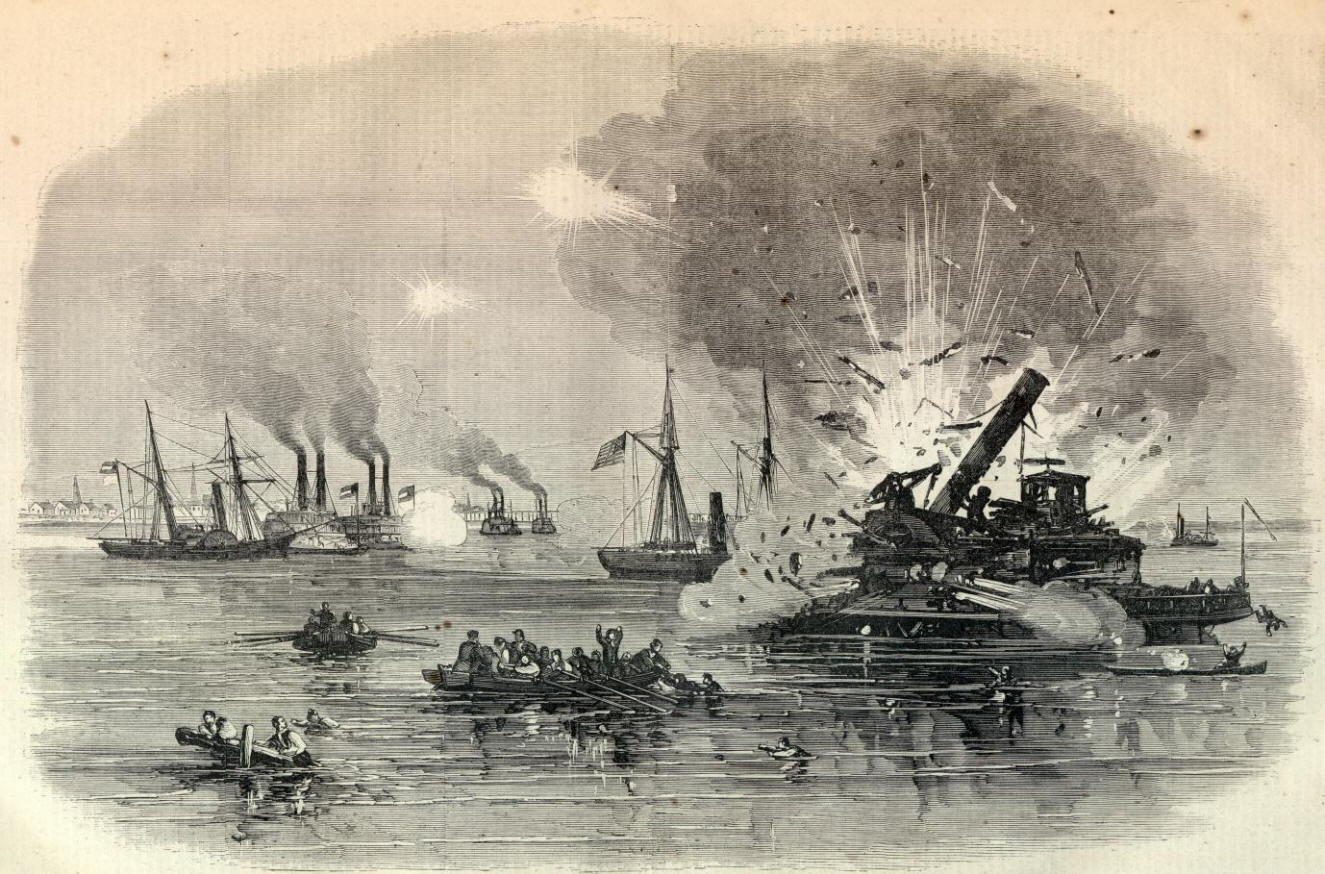
USS Westfield, aground on a sandbar, blows up, killing Union Fleet Commander William B. Renshaw and twelve members of his crew. Federal forces had blockaded Galveston in October 1862 and soon forced the garrison to evacuate, but without reinforcements could hold no more ground than could be covered by their ships' guns. Before Banks’ 30,000 men arrived, at 3:00 AM on Jan 1st Confederate forces under Maj. Gen. John B. Magruder retook the city by land, while in a savage night battle two Southern cottonclads engaged the Union fleet of six ships. The Bayou City rammed the Harriet Lane, and her complement of infantry stormed across to take the Federal vessel by storm. Union Fleet Commander William B. Renshaw ran his flagship USS Westfield aground on a sandbar, and in attempting to prevent its capture accidentally blew up himself and twelve members of his crew. The rest of the fleet abandoned their troops onshore, who surrendered. Banks’ army was forced to disembark in New Orleans. The US Navy had resumed its blockade when, at dusk on Jan. 11, the Alabama appeared on the horizon. 
“I certainly had not come all the way into the Gulf of Mexico, to fight five ships of war, the least of which was probably my equal,” wrote Semmes. “...Whilst I was pondering the difficulty, the enemy himself, happily, came to my relief; for pretty soon the look-out again called from aloft, and said, ‘One of the steamers, sir, is coming out in chase of us.’” The 1,100-ton converted passenger ferry USS Hatteras had taken Alabama for a hapless blockade-runner, and churned out alone in pursuit. Semmes’ mission was to destroy Union merchant shipping, but he wasn’t above picking a fight with the proper foe. “She was evidently a large steamer,” he wrote of the Hatteras, “but we knew from her build and rig, that she belonged neither to the class of old steam frigates, or that of the new sloops, and we were quite willing to try our strength with any of the other classes.” Easily capable of outrunning the iron-hulled side-wheeler, Semmes shortened sail and only put on enough steam to appear catchable, luring Hatteras ever further out to sea. After twenty miles, under cover of dusk, he took in his sails, unlimbered his guns and came about to await his would-be captor. Union Lt. Cmdr. Homer C. Blake was beginning to think something amiss. Turning to bare his own broadside, such as it was—a mere pair of 32-pounders and two even smaller rifled guns—he called across the water, “What ship is that?” The Confederates replied, “This is her Britannic Majesty’s steamer Petrel.” “If you please, I will send a boat on board of you.” “Certainly, we shall be happy to receive your boat,” Semmes answered and, as the Union boarding crew put down and began rowing across, turned to Executive Officer Kell. “I suppose you are all ready for action?” “We are,” said Kell, “the men are eager to begin, and only awaiting your word.” Semmes gave it. Kell stood up and shouted through his bullhorn, “This is the Confederate States steamer Alabama!” and the raider let fly a full broadside. 
CSS Alabama and the USS Hatteras off Galveston, Jan. 11, 1863. Built in 1861, the sidewheel passenger steamer St. Mary was purchased by the U.S. Navy that September, renamed the Hatteras and converted into a gun boat carrying four 32-pounder cannon and a 20-pounder rifled cannon, under Commander George F. Emmons. No pushover, in January 1862 the Hatteras made a highly successful raid on the harbor at Cedar Keys, Fla, burned seven small blockade runners, destroyed the important Florida Railroad terminus, and captured 14 of the 22-man garrison, including the commanding officer. Over the course of the year the Hatteras captured seven more blockade runners, mostly off Vermilion Bay, Louisiana. Emmons even put four of his own men on board the prize 20-ton sloop Poody and rechristened her Hatteras Jr.—an ex-blockade runner now enforcing the blockade. The crew of the Hatteras, having smelled trouble, answered immediately. The men in the cutter ducked as shot and shell flew low overhead in both directions. Giving throttle, the two warships conducted a running gunfight at ranges right down to 25 yards, so close their crews traded shots with muskets and revolvers. Several shells from Hatteras went through Semmes’ cabin and one passed narrowly over his head on the quarterdeck, but none struck below the waterline. The battle could only end one way. “The action was very sharp and exciting while it lasted, which was not very long,” wrote Semmes, “for in just thirteen minutes after firing the first gun, the enemy hoisted a light and fired an off[side]-gun, as a signal that he had been beaten. We at once withheld our fire, and such a cheer went up from the brazen throats of my fellows, as must have astonished even a Texan, if he had heard it.” The men of the Galveston fleet did hear, if not the cheers of the Southerners, the reports of their big pivot guns and, seeing their flashes on the horizon, realized Hatteras had stumbled into a fight. Raising anchor and steaming out in all haste to assist, they passed the little cutter—its crew, as might be imagined, stroking with all their might for shore—but found no trace of the Alabama. “As soon as the action was over, and I had seen the [Hatteras] sink,” wrote Semmes, “I caused all lights to be extinguished on board my ship, and shaped my course again for the passage of Yucatan.” In the morning the US flagship Brooklyn, already humiliated in Semmes’ escape from New Orleans, found the Hatteras resting on the shallow bottom of the Gulf with a pennant still flying from the tip of her mainmast, a few feet above the waves. (Uncovered by hurricanes and storms and discovered in the 1970s, today the Hatteras’ 210-foot hull is buried in three feet of sand, 60 feet underwater, 20 miles off Galveston. The remains of her 500-hp engine and two iron paddle wheels remain accessible and, as an important underwater archaeological site, the Hatteras is the subject of investigation by the Bureau of Ocean Energy Management, the Texas Historical Commission, and Texas A&M University at Galveston.) Semmes put Capt. Blake and his crew, of which two had been killed and five wounded, ashore in Kingston, Jamaica. (His own crew suffered but one man wounded.) While Alabama took on coal and repairs, her captain enjoyed an island holiday with his admiring British hosts. 


The USS Kearsarge A Mohican-class sloop-of-war, the Kearsarge was among the Union warships that blockaded Semmes’ first raider, the Sumter, at Gibraltar in 1862. Winslow was to have taken command in December of that year, but Kearsarge was laid up in Cádiz for repairs and did not rendezvous with her new captain in the Azores until April 1863. It was in the Azores that Winslow took his executive officer’s advice and added chain armor to her sides. 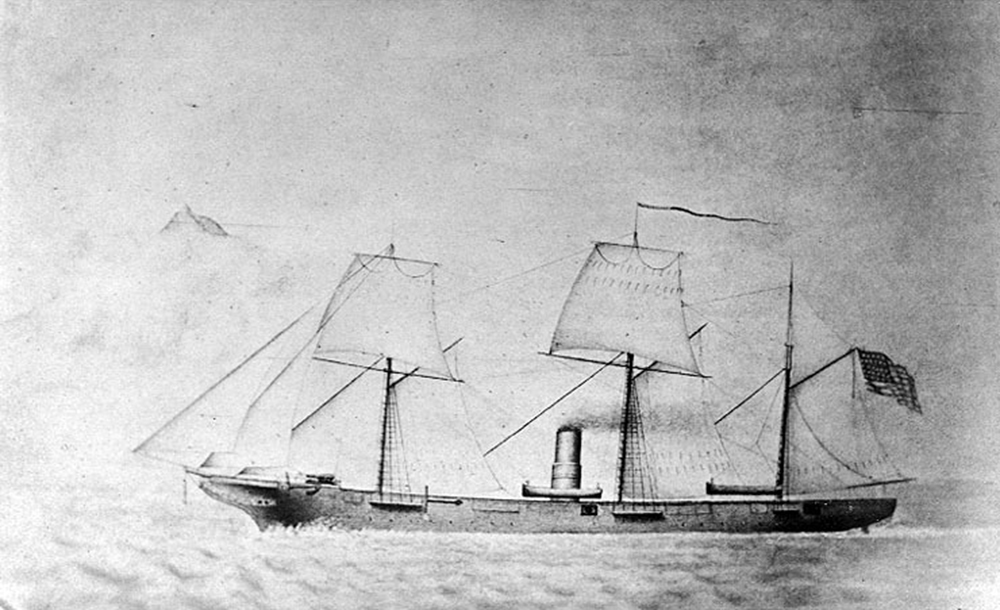
USS Kearsarge in the Azores By March, Winslow, still stuck in the Azores, was grumbling, “The Kearsarge has been in [dry] dock, repairing at Cadiz, long enough to have built a vessel in the United States, and I am not aware that she has yet got out.” In finally delivering his ship to her new master, Capt. Pickering managed to pass the brand new raider CSS Georgia, on her shakedown cruise from Scotland around the southern end of England to the island of Ushant, off France. (Pickering would top his career as captain of the screw sloop USS Housatonic the following February, when she was sunk in Charleston harbor by the Confederate submarine H.L. Hunley.) Come the handover on April 8th, Winslow had plans ready to put into action. 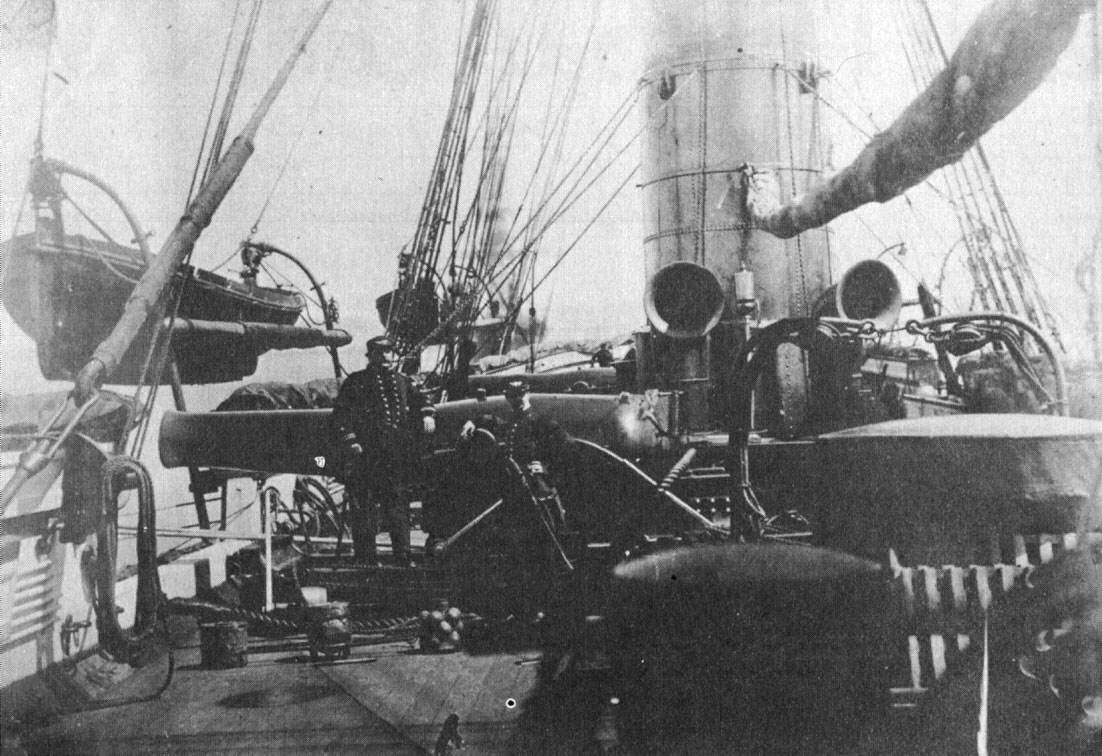
Dahlgren Pivot Gun Kearsarge’s armament would be no great advantage over the Alabama. She mounted only four 32-pounders, though her main pivot guns were larger than Semmes’: two 11-inch smoothbores designed by Capt. John Dahlgren of the Navy Ordnance Department. Each, made of one piece of cast iron weighing nearly eight tons, could fire a 166lb shot or 133lb explosive shell 2,300 yards, or through four inches of steel and twenty inches of oak. Wooden bulkheads being no longer sufficient against such weaponry, Winslow determined to make his ship into an ironclad. His executive officer, Lt. Cmdr. James S. Thornton, had served as exec on Capt. David G. Farragut’s flagship, USS Hartford, during the Union naval assault on New Orleans in April 1862, when she grounded under the guns of Fort St. Philip and only an improvised iron mail of heavy chains hung over her sides kept her from being shot to pieces. Thornton now proposed the same protection for the Kearsarge. 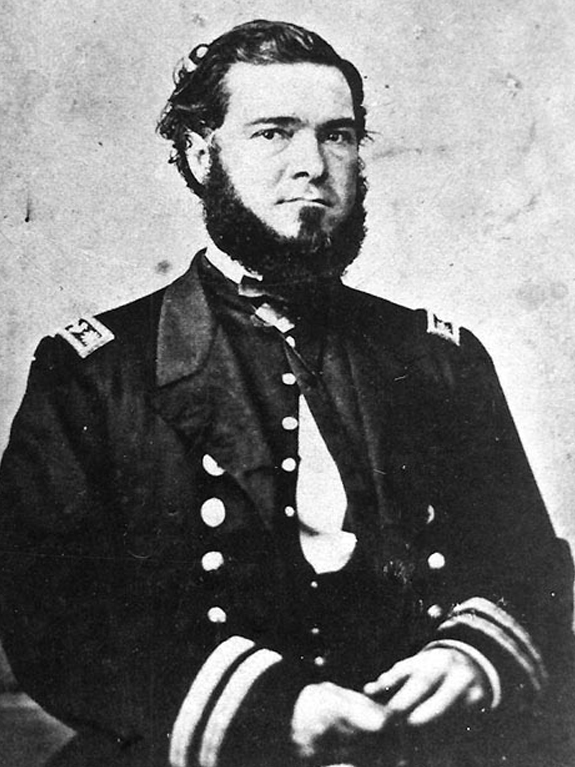
Kearsarge executive officer Lt. Cdr. James S. Thornton 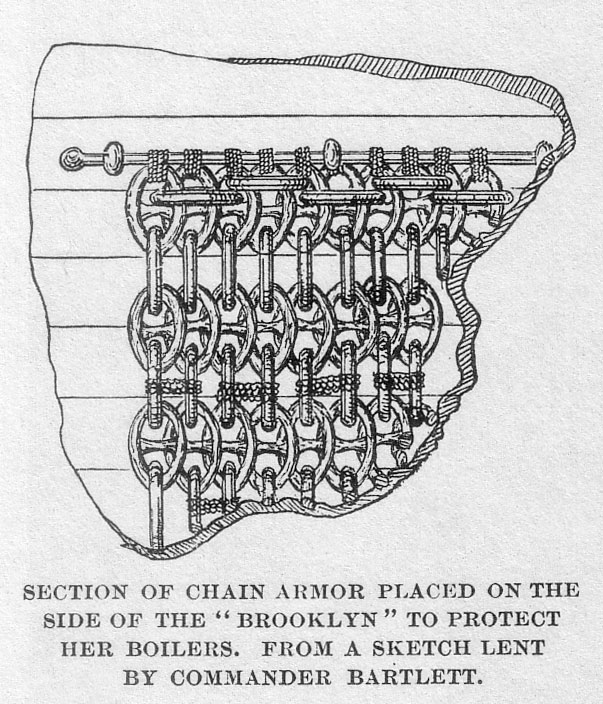
Chain armor as installed on the side of the sloop-of-war USS Brooklyn. “We remained ten days...at Fayal [in the Azores], where we were employed putting on a cuirass, or rather plating our vessel for some thirty feet each side, to protect our machinery,” Winslow wrote. “This plating consists of our heavy [spare anchor] chains, suspended close together, which are hung to the sides of the vessel, and makes a complete armor for protection against shot, etc.” Once overlaid with a veneer of planks streamlined with beveled edges all around, from any distance the armor was nearly invisible. Meanwhile the Alabama had ranged down the coast of South America on what would be her most lucrative raid. Preying on merchant traffic coming up from Cape Horn, since February Semmes had captured or burned 19 vessels, on several occasions two or even three a day. By mid-May, when Winslow was finishing up his armor in the Azores, Alabama was carrying no less than four ships’ crews prisoner, and stopped off in Bahia, Brazil, to put them ashore and take on coal. By complete coincidence she was met by the Georgia, fresh from Ushant on her maiden raid; also by coincidence, Alabama’s sister ship CSS Florida was just up the coast at Pernambuco. The Confederates had formed an inadvertent South Atlantic Squadron. Though all three raiders were on separate missions and soon parted company, the possibilities must have made themselves plain to Semmes. Capturing seven more ships in the South Atlantic by the beginning of June, he transferred spare crewmen and a pair of captured cannon to the 350-ton bark USS Conrad and rechristened her the raider CSS Tuscaloosa. “Never, perhaps, was a ship of war fitted out so promptly before,” he recounted proudly. “The Conrad was a commissioned ship, with armament, crew, and provisions on board, flying her pennant, and with sailing orders signed, sealed, and delivered, before sunset on the day of her capture.” The Confederate high-seas raiders were beginning to reproduce. 
Confederate Raiders in the South Atlantic 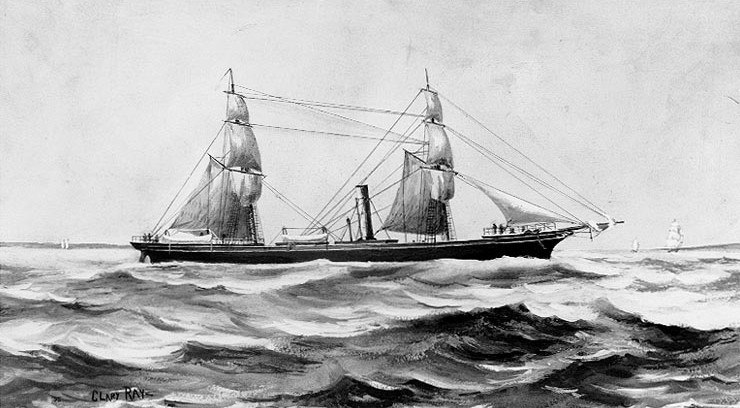
CSS Georgia 
CSS Florida 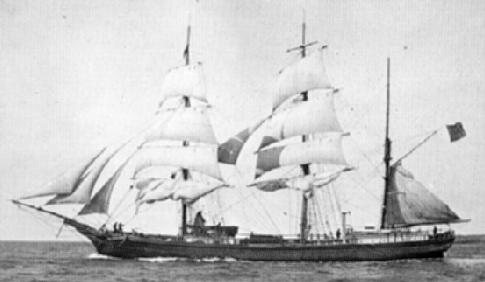
CSS Tuscaloosa 
Global Sensation: The Alabama in Cape Town 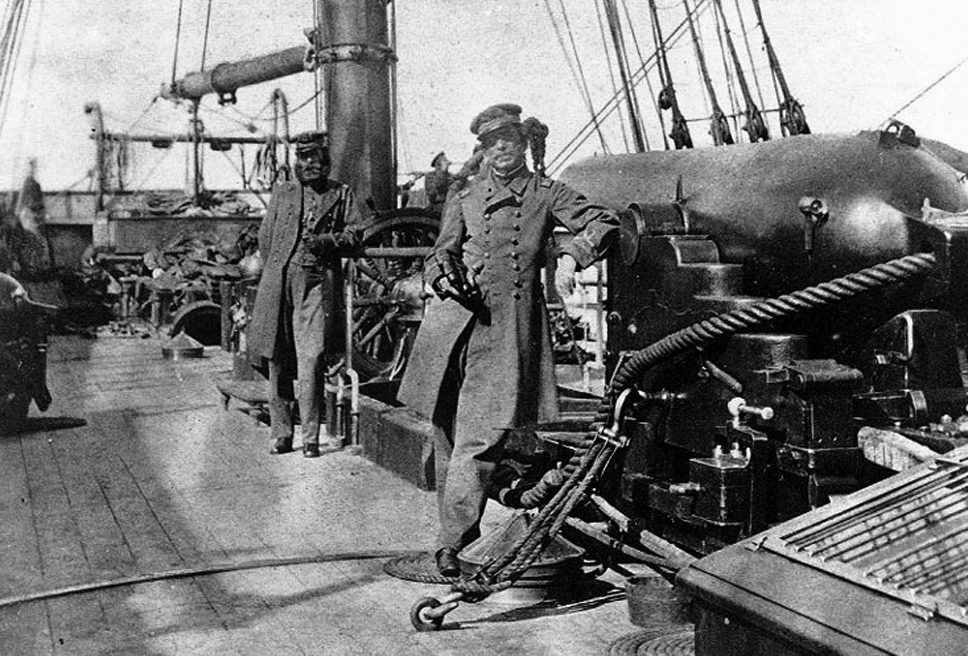
Captain Semmes of the Alabama, Cape Town, South Africa, August 1863 Lt. Kell leans near the ship’s wheel, with several crewmen visible in the background and one (near Kell’s right knee) poking his head out from below. 
First Lieutenant John McIntosh Kell 
Crew of the Alabama Those in the crew photo were long described as Semmes, foreground, and Second Lieutenant Richard Armstrong leaning on the hoist over the skylight, but the main figure is now thought to be the captain’s secretary, W. Breedlove Smith, with Sailing Master Irving Bulloch by the wheel. Crew further aft by the stern flag-locker are unknown. By the time she reached Cape Town, South Africa, in August 1863, Alabama was an international sensation. “Three hearty cheers were given for Captain Semmes and his gallant privateer,” declared the Cape Town Argus. “This, upon the part of a neutral people, is, perchance, wrong.... It was not, perhaps, taking the view of either side, Federal or Confederate, but in admiration of the skill, pluck, and daring of the Alabama, her captain, and her crew, who afford a general theme of admiration for the world all over.” News from home, however, was all bad: Gettysburg and Vicksburg lost, the Mississippi under Federal control from the Ohio to the sea. “From the whole review of the ‘situation,’” Semmes wrote, “I was very apprehensive that the cruises of the Alabama were drawing to a close. As for ourselves, we were doing the best we could, with our limited means, to harass and cripple the enemy’s commerce, that important sinew of war; but the enemy seemed resolved to let his commerce go, rather than forego his purpose of subjugating us.” Though he again enjoyed British hospitality, Semmes tarried around the Cape no longer than was necessary to obtain coal and repairs. The Vanderbilt was hunting him (on Sept. 11th they passed just over the horizon from each other), and he was loath to be trapped again under blockade. Reasoning his foe would lie in the shipping lanes toward Madagascar, he set out due east and, blown before southern midwinter gales, Alabama covered 2,840 miles in two weeks, turning up northwest of Australia toward the East Indies. Alas, the long reach of the US Navy extended even to that part of the world. The screw sloop USS Wyoming, fresh off a victory over the upstart Japanese, was haunting the Sunda Strait in hopes of intercepting the Alabama. Semmes was in the mood for a fight. “Wyoming is a good match for this ship,” he wrote in October. “I have resolved to give her battle. She is reported to be cruising under sail—probably with banked fires—and anchors, no doubt, under Krakatoa every night, and I hope to surprise her, the moon being near its full.” The Alabama and Wyoming, however, never crossed paths. Nor was there precious little quarry either. Semmes had been too successful: American ships either stayed in harbor waiting for him to vacate the area, or “sold” themselves to neutral nations, putting themselves beyond capture. Alabama ranged as far as Singapore and Vietnam, but through November and December took only six vessels. 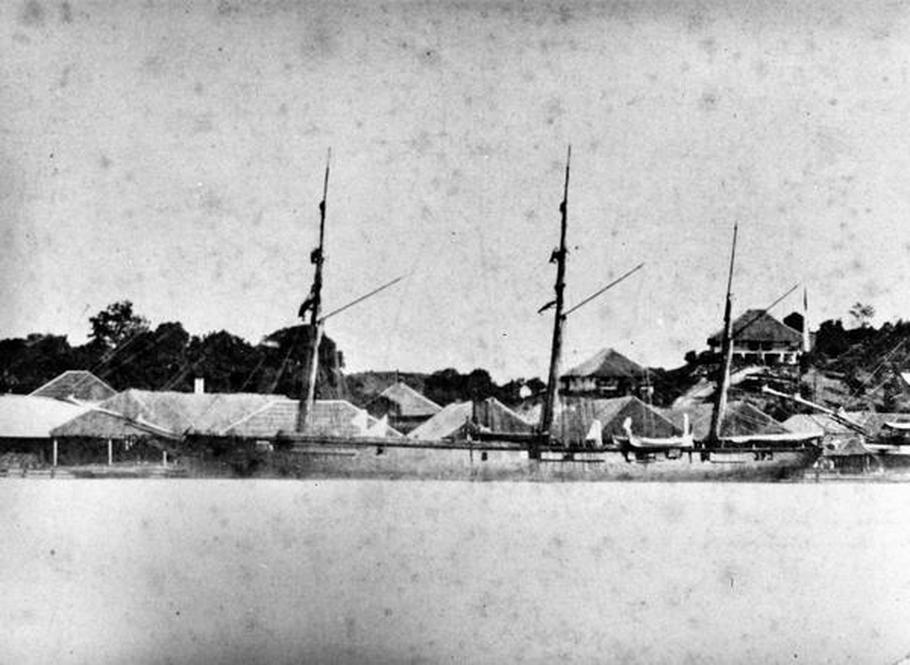
CSS Alabama, December 1863 One of the few actual photos of the Alabama, taken in Singapore just before Christmas 1863. Stainless Banner hangs from the gaffsail arm. “Sea-life is becoming more and more distasteful to me,” Semmes wrote. “The fact is, I am reaching an age when men long for quiet and repose.” (A Cape Town paper had written, “He is 53 but looks much older.”) With his ship’s innards weeping seawater, her bottom peeling copper and trailing algae, and her crew growing surly, he decided enough was enough: “Well, we are on the sea once more, with our head turned westward, or homeward. Shall we ever reach that dear home which we left three years ago, and which we have yearned after so frequently since? Will it be battle, or shipwreck, or both, or neither? And when we reach the North Atlantic, will it still be war, or peace? When will the demon-like passions of the North be stilled?” 

Winslow and the Kearsarge spent that winter attempting to singlehandedly blockade England, Ireland, France and Spain. They left the Florida in drydock at Brest, France, to try catching the Georgia at Queenstown, Ireland, but the Georgia put in at Cherbourg instead. Winslow gained nothing but sixteen Irishmen who wished to join his crew. When Her Majesty’s Foreign Office got wind of it, Winslow was accused of signing them in violation of the Foreign Enlistment Act. “The English all hate this ship,” he wrote, “and took bold of this act to try and make something out of it.... This thing has cost me more writing than would fill a quire of paper.” He declared the new hands to be stowaways and put them back ashore, but the damage was done. By April Winslow was being accused in the House of Lords of violating British neutrality, to which he answered in the press, calling the Irishmen in question “miserable trash” and calling into question British motives in the dispute, with his usual tact managing to offend everyone involved. Even as the CSS Rappahannock (ex-HMS Victor) put in at Calais and the Aggrippina at Plymouth, England and France both forbade the Kearsarge to anchor within their ports for more than 24 hours at a time. With an international incident on his hands, Ambassador Adams felt compelled to submit a full report to Washington. Winslow’s career prospects were not improved by his complete inability to capture, destroy or even detain a single enemy ship; while he was distracted with legalities, in February both the Florida and the Georgia escaped harbor. “If we had more ships here,” wrote the near-disgraced captain, “we certainly could have got the Georgia or Florida.” Injury was added to insult in Ostend, Belgium, where a harbor pilot managed to bounce Kearsarge off a local fishing boat, a bridge and a pier before running her aground. “The accident was so egregious a blunder,” Winslow reported, “as led the officers to say the pilot was bribed; for no person of the meanest capacity could not have prevented it.” He put in at Flushing, Netherlands (modern Vlissingen) for repairs. His letters reveal that, like his old friend Semmes, the travails of war were wearing him down. “I find I have not the health that I had, and that ‘Mississippi fever’ has done its work, with my old blind eye, and a constitution which is extremely susceptible to cold, which always increases the inflammation in eye and ears, I am fast running down hill.” 

“My intention now was to make the best of my way to England or France,” Semmes had decided, “for the purpose of docking and thoroughly overhauling and repairing my ship.” Kearsarge was lying in the Scheldt Estuary when, on June 12th, Winslow received word that the Alabama had put in at Cherbourg. 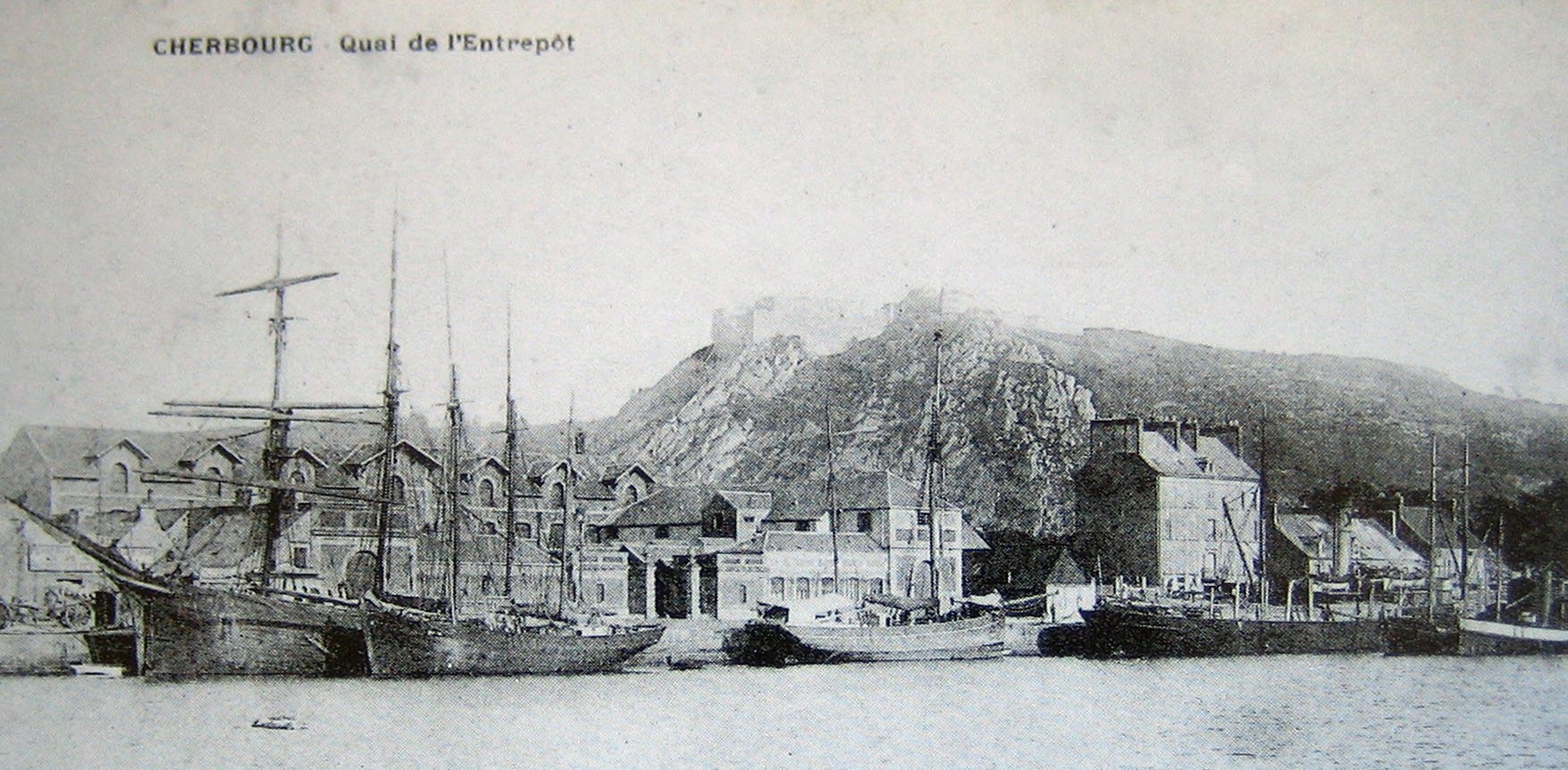
Quai de l’Entrepôt (Warehouse Wharf), Cherbourg, France In an era when few warships could go a year and a half without putting in for an overhaul, Alabama had been at sea for 22 months without seeing as much as a dry dock, let alone a home port. Her beams were splitting, her decks were sagging, her boilers were corroded with salt water and her bottom was dragging barnacles, seaweed and copper plating. But this was 1864, not 1862. Then, victory had seemed within the South’s grasp, and the European powers had been sympathetic, even encouraging. No longer. “The last batch of newspapers captured were full of disasters,” Semmes wrote. Chattanooga had fallen. Maj. Gen. William T. Sherman had invaded Georgia. Maj. Gen. J.E.B. Stuart had been killed at Yellow Tavern. And in the Wilderness, new Northern commander-in-chief Ulysses S. Grant had proven the Union willing to wage a bloody war of attrition, no matter how high the cost, on land as at sea. In almost two years of voyaging, the Alabama had captured or sunk almost 70 American ships, valued at $5,500,000 (about $80,000,000 today), but as Semmes saw it no amount of loss, financial or otherwise, could deter the North: “Might it not be, that, after all our trials and sacrifices, the cause for which we were struggling would be lost? Might not our federal system of government be destroyed, and State independence become a phrase of the past; the glorious fabric of our American liberty sinking, as so many others had done before it...? The thought was hard to bear.” Cherbourg was not a civilian but a military port, and France was no longer eager to host a belligerent vessel. Alabama would be permitted to repair, or coal, but not both, and she was to be on her way as soon as possible. With the Confederacy’s most notorious high-seas raider finally in a pot, however, the US Navy promptly slammed shut the lid. The Alabama dropped anchor on June 12th; on June 14th, the Kearsarge took up station outside the Cherbourg breakwater. But neither was this the same Raphael Semmes who had submitted to blockade two years earlier. He and Lt. Kell talked over their options, which were few. They had orders to avoid combat. They could remain in port, in which case more Federal cruisers would flock to Winslow’s aid and see to it the Alabama rotted at anchor. Or they could fight. If they were defeated, the outcome for the Confederacy would be the same: one ship lost. A victory, on the other hand, would not only be momentous for Semmes and his crew, who could turn the Kearsarge, if captured, into a fresh new raider; for the Confederacy it would be a public relations coup that might even sway the European powers back to her side. And there was a good chance the Alabama would be victorious, for on paper at least she and the Kearsarge were an even match in size, crew and armament. Historians have debated whether Semmes was aware of Winslow’s chain cladding; in his memoirs he claimed to have learned of it only after the fact, though it seems to have been common knowledge aboard his ship. He may simply have discounted their existence as rumor, or decided that it made no difference. For the Alabama, to deny battle was tantamount to defeat. “The combat will no doubt be contested and obstinate,” Semmes wrote, “but the two ships are so equally matched that I do not feel at liberty to decline it. God defend the right, and have mercy upon the souls of those who fall, as many of us must.” 

Accordingly, he sent word ashore: “I desire to say to the U. S. consul that my intention is to fight the Kearsarge as soon as I can make the necessary arrangements. I hope these will not detain me more than until tomorrow evening, or after the morrow morning at furthest. I beg she will not depart before I am ready to go out.” Semmes used the interval to choose coal over repairs, filling the bunkers around his ship’s machinery with an extra 150 tons of Welsh anthracite as his own kind of armor. He sent ashore five bags of gold sovereigns, about $5,000 each, bonds from his surviving victims, and a collection of ships’ chronometers taken from the rest. Meanwhile the Kearsarge prowled back and forth outside the breakwater, Winslow running gun drills and reordering his ammunition stores for easy access. 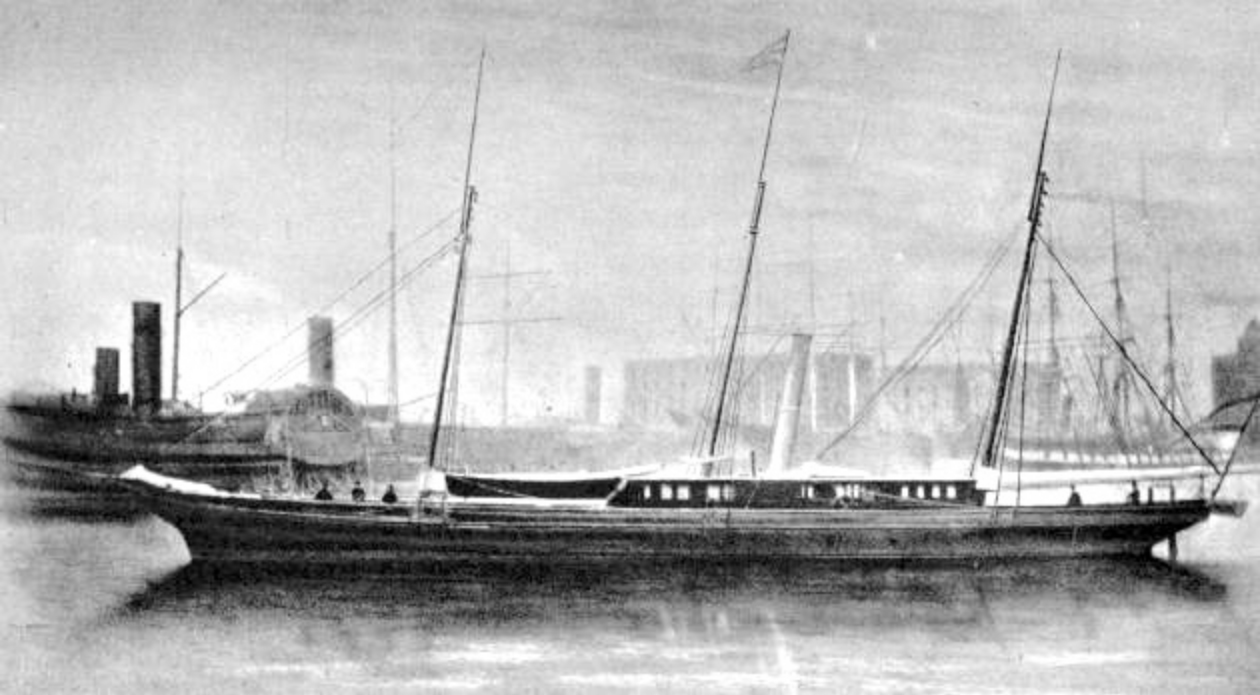
Deerhound Word of the impending fight spread across France. A new rail line from Paris had just opened; Cherbourg’s hotels filled with tourists eager to witness history. (French Impressionist painter Edouard Manet, usually claimed to have watched the fight from a boat, likely did not arrive until after the battle and rendered his famous depiction later, from spectator accounts.) On Friday the English yacht Deerhound steamed in from the Isle of Jersey to meet her owner, John Lancaster of the Lancashire Union Railway, who had brought his family from holiday in St. Malo to see the show. 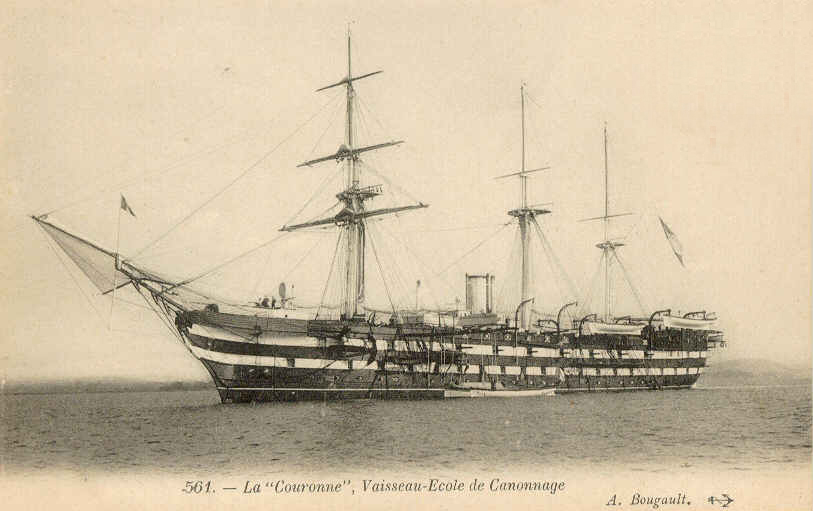
Couronne Saturday, June 18th, was stormy with heavy seas preluding combat, but Sunday dawned clear. By 6:10 AM the Alabama’s boilers were lit; by 7:50 she had sufficient steam; and at 9:45 she set out for open water. The Deerhound, with the Lancaster family aboard, accompanied her from the anchorage, as did several little harbor pilot boats crowded with paying customers. The French ironclad Couronne, on hand to enforce the host’s neutrality, escorted the little fleet out past the breakwater’s western tip. The Kearsarge was about five miles out in the Channel. Captain Winslow had finished the morning inspection and was about to conduct Sunday services when Quartermaster Charles Butts, keeping an eyepiece trained landward, called, “She’s coming!” Seeing for himself, Winslow ordered the crew drummed to general quarters and the Kearsarge further out to sea. He had strict instructions not to let any battle infringe on French territorial waters, and for once was following orders to the letter. 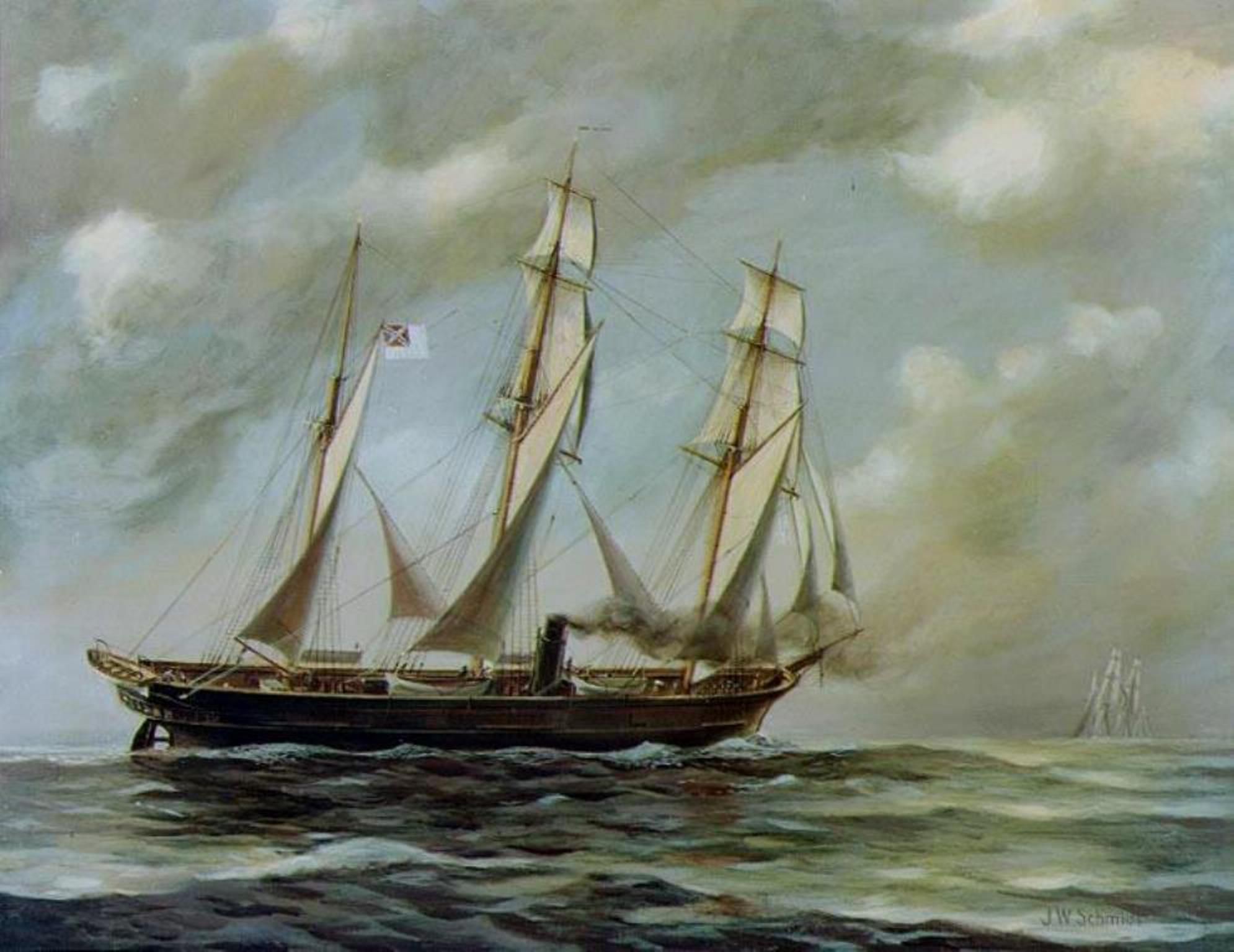
To the 19,000 spectators, picnickers and vacationing families watching from the high ground around Cherbourg, especially to the west around the famous Chapel of St. Germain on the point of Querqueville, it must have seemed the Federals were running for it. The betting was running hot and heavy, with the odds favoring the Alabama. Peddlers were doing a land-office business in camp-stools, telescopes and cheap binoculars. The wind was blowing from the west, though that mattered little to steamers, which fought with furled sails; the current was flowing at about three knots to the southwest. At the three-mile limit the Couronne sheered off to stand guard. The Deerhound and the pilot boats stayed in trail for a close-up view of the action as the Alabama closed on her enemy. Winslow had gone to his cabin and traded his uniform cap for an old, weather-beaten one, as though determined to battle his old friend as he had so often battled the sea. Kearsarge was now six or seven miles from shore. Her boilers were running at a high heat. Her guns were loaded with shells on 5-second fuzes. The 11-inch Dahlgrens had been pivoted over to starboard. Gun ports were lowered. Cannoneers stood with their lanyards in hand. Lt. Thornton had ordered sand scattered across the deck, lest it become slippery with blood. The ship’s officers shook hands and went to their posts. Taking up station at the foot of the mizzenmast, Winslow ordered the Kearsarge to come about and asked for full steam. Observers could see black smoke gush from the Union ship’s stack as she turned bow-on to the enemy. (Unlike Alabama’s clean-burning anthracite, Kearsarge ran on bituminous coal from Newcastle.) There could be no doubt now that Winslow intended to make a fight of it. The ships were about a mile and a quarter apart. Calling his crew aft, Semmes had stepped up on a gun carriage, much as he had that first time in the Azores, two years before. “Officers and seamen of the Alabama! You have, at length, another opportunity of meeting the enemy—the first that has been presented to you, since you sank the Hatteras! In the meantime, you have been all over the world, and it is not too much to say, that you have destroyed, and driven for protection under neutral flags, one half of the enemy’s commerce, which, at the beginning of the war, covered every sea. This is an achievement of which you may well be proud; and a grateful country will not be unmindful of it. The name of your ship has become a household word wherever civilization extends. Shall that name be tarnished by defeat? The thing is impossible! Remember that you are in the English Channel, the theatre of so much of the naval glory of our race, and that the eyes of all Europe are at this moment, upon you. The flag that floats over you is that of a young Republic, who bids defiance to her enemies, whenever, and wherever found. Show the world that you know how to uphold it! Go to your quarters.” All of the guns were loaded with solid shot. One of Alabama’s port-side 32-pounders had been rolled over to fire to starboard, and both her big Blakely pivot guns were also turned that way. The forward 7-inch rifle had the advantage of range over any other gun in the battle, including even the Kearsarge’s Dahlgrens, and Semmes was determined to strike the first blow. The ships were about a mile apart when, at about 11:00 AM, he ordered Alabama over to port. As her bow swung away and she heeled, the starboard gunners raised their muzzles to compensate, realizing their captain, right out of the box, was going for the Holy Grail of a gunfight at sea. With the Kearsarge coming straight at them, he intended to “cross the T”: bring a full broadside to bear on the enemy’s bow and rake her, stem to stern. At that range it went unrecorded, and possibly unseen, how many of the little 32-pounders fell short. At least one round—probably from the 7-inch rifle—went high, snapping a line high up in the Kearsarge’s fore-top rigging. “Hold your fire, Mr. Thornton,” Winslow said. “Steady as you go.” With no Union reply, Semmes had his men reload and fire another salvo. Their aim was again surprisingly high, but so was their rate of fire. With the ships closing rapidly, Winslow knew they would soon pour it into the Kearsarge. “The range if you please, Mr. Thornton,” he said. The order was passed to the crew of a 30-pound Parrot rifle on the forecastle, the smallest but longest-ranged of the Union guns. Its crew of US Marines fired a shot, more for appearances than effect. Winslow knew the moment was upon him. He ordered, “Sheer to port!” Even as the Union ship peeled away to pass them by, the Confederates got off a third broadside, but the total effect was nil. The Kearsarge had survived the interval of her disadvantage; the two sloops, passing each other on their starboard sides, were less than a thousand yards apart when Winslow ordered, “Fire at your pleasure!” It was about twelve minutes into the battle. Kearsarge unleashed her first broadside to immediate effect. A 32-pound shell went through the Alabama’s forward pivot-gun port, ripped the leg off one of the gun’s crew, ricocheted off its slide and wounded a man at another gun. As the two ships passed, Winslow ordered the wheel hard over. The Kearsarge answered, banking hard to starboard. Having nearly had his bow crossed, Winslow intended to turn the tables and cross the enemy’s stern. But Semmes had the same idea; the Alabama was likewise turning to starboard. The two ships swung around after each other’s tails, on opposite sides of a circle, broadside to broadside. “He’s got to fight now!” Winslow declared. “Old Beeswax can’t straighten out and head for shore without getting raked.” He ordered his 32-pounders to clear the enemy’s decks, and his pivot guns to shoot low and open her up under the waterline. Semmes did likewise: “I had directed my men to fire low, telling them that it was better to fire too low than too high, as the ricochet in the former case—the water being smooth—would remedy the defect of their aim, whereas it was of no importance to cripple the masts and spars of a steamer.” “The remainder of the fight,” Kell recalled, “occurred at a distance of not more than 500 yards.” Newspapers claimed afterward that Semmes intended to carry the battle the old-fashioned way, by closing and boarding, but in the age of steam that was only possible if the victim had a crippled engine, screw, or rudder. A faster ship could always maintain distance; a slower ship could simply stop, let the faster pass, and cross behind it to fire. Off Cherbourg the Kearsarge, with her four-bladed prop and her freshly careened bottom, had the advantage of speed over the Alabama’s two-bladed prop and fouled hull. Only by a masterful job of sailing could Semmes keep Winslow from gaining on him around the circle and crossing his wake. 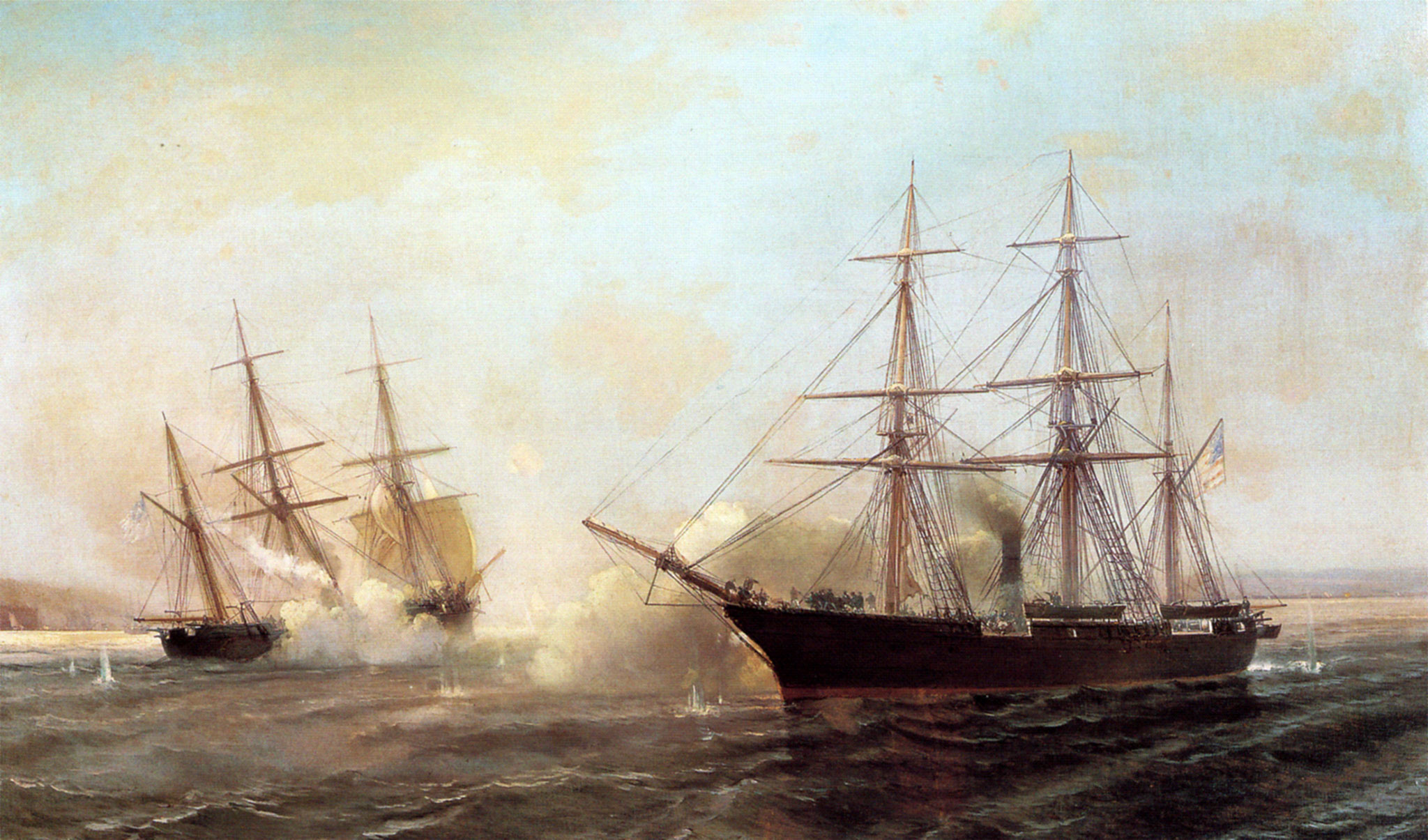
Battle of the USS Kearsarge and the CSS Alabama 1864. A Union shot cut away the Alabama’s spanker gaff (top rearmost sail), from which flew the ship’s Stainless Banner, white with a Southern Cross in the canton. The Union gunners cheered to see it fall; the Confederates cheered to see another run up the mizzenmast. “When we got within good shell range,” Semmes reported, “we opened upon him with shell.” At about 11:20 the forward 7-inch Blakely put an explosive round into the Kearsarge amidships, but her chain armor bounced the round up and out through the engine room skylight. The Union crew had no time to celebrate their close call before another 7-inch round struck aft, shuddering the entire ship. “Mr. Thornton!” called Winslow. “See what damage that one did!” Thornton had barely left his post when the Confederates’ aft 8-inch Blakely landed a shell near the Kearsarge’s aft pivot gun. When the smoke cleared, three Union crewmen lay sprawled on the deck, two with horribly broken legs (one later died) and one with an arm nearly torn off. Few of the Confederate shells, however, had such explosive effect. “I should have beaten [Winslow] in the first thirty minutes of the engagement,” declared Semmes later, “but for the defect of my ammunition, which had been two years on board, and become much deteriorated by cruising in a variety of climates.” Thornton reported a shell from the Alabama’s 100-pounder had lodged in the ship’s sternpost, a dud. Had it gone off, it would surely have opened the Kearsarge up to the sea; as it was, the ship’s rudder was nearly jammed, requiring four men to turn her wheel, preventing her from gaining the Alabama’s stern and finishing the fight. 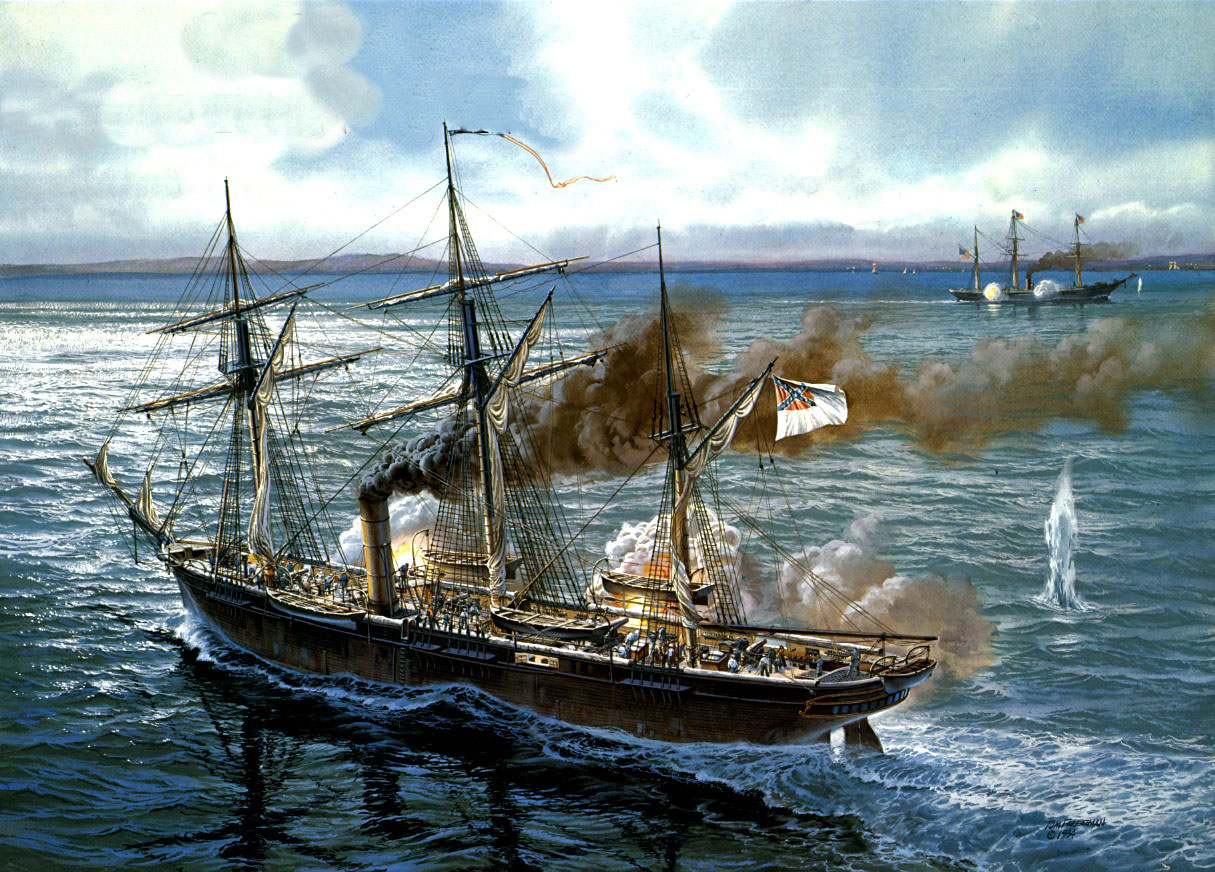
Sunday Showdown So far the Alabama had suffered just one man killed and two wounded, a nicked mainmast and the lost gaffsail. On the other hand, those Confederate shells striking the Kearsarge’s vital area amidships were having little effect against her armored hull. “This planking had been ripped off, in every direction, by our shot and shell, the chain broken, and indented in many places, and forced partly into the ship’s side,” Semmes learned later. “She was effectually guarded, however, in this section, from penetration.” “Mr. Kell,” Semmes called, “our shells strike the side of the enemy’s ship but they fall into the water. Try solid shot.” “Perceiving that our shell, though apparently exploding against the enemy’s sides, were doing him but little damage,” Semmes reported, “I returned to solid-shot firing, and from this time onward alternated with shot, and shell.” The Confederates poured it on, firing at almost twice the rate of the Union gunners. A 100-pounder round blew a hole through the Kearsarge’s stack, letting black coal smoke pour low over the deck. Two 32-pound shells entered right through the Federals’ own 32-pounder ports, miraculously not striking a single crewman even though one caromed completely across the deck and started a fire in the opposite side hammock netting. 
A Dahlgren gun crew aboard the Kearsarge. “Sound the alarm for fire quarters,” Winslow ordered. As men doused the flames, the gun crews remained steady, waiting patiently for the smoke to clear, taking their time, taking careful aim. Watching through his scope, Semmes said, “Confound them; they’ve been fighting twenty minutes, and they’re cool as posts.” “My position was near the eight-inch gun,” recalled Kell. “An eleven-inch shell from the Kearsarge entered a port hole and killed eight of the sixteen men serving that gun.” When the smoke cleared he saw, “The men were cut all to pieces, and the deck was strewn with arms, legs, heads and shattered trunks. One of the mates nodded to me as if to say, ‘Shall I clear the deck?’ I bowed my head and he picked up the mangled remains of the bodies and threw them into the sea.” Kell ordered a 32-pounder crew to take over the Blakely, and the battle went on. 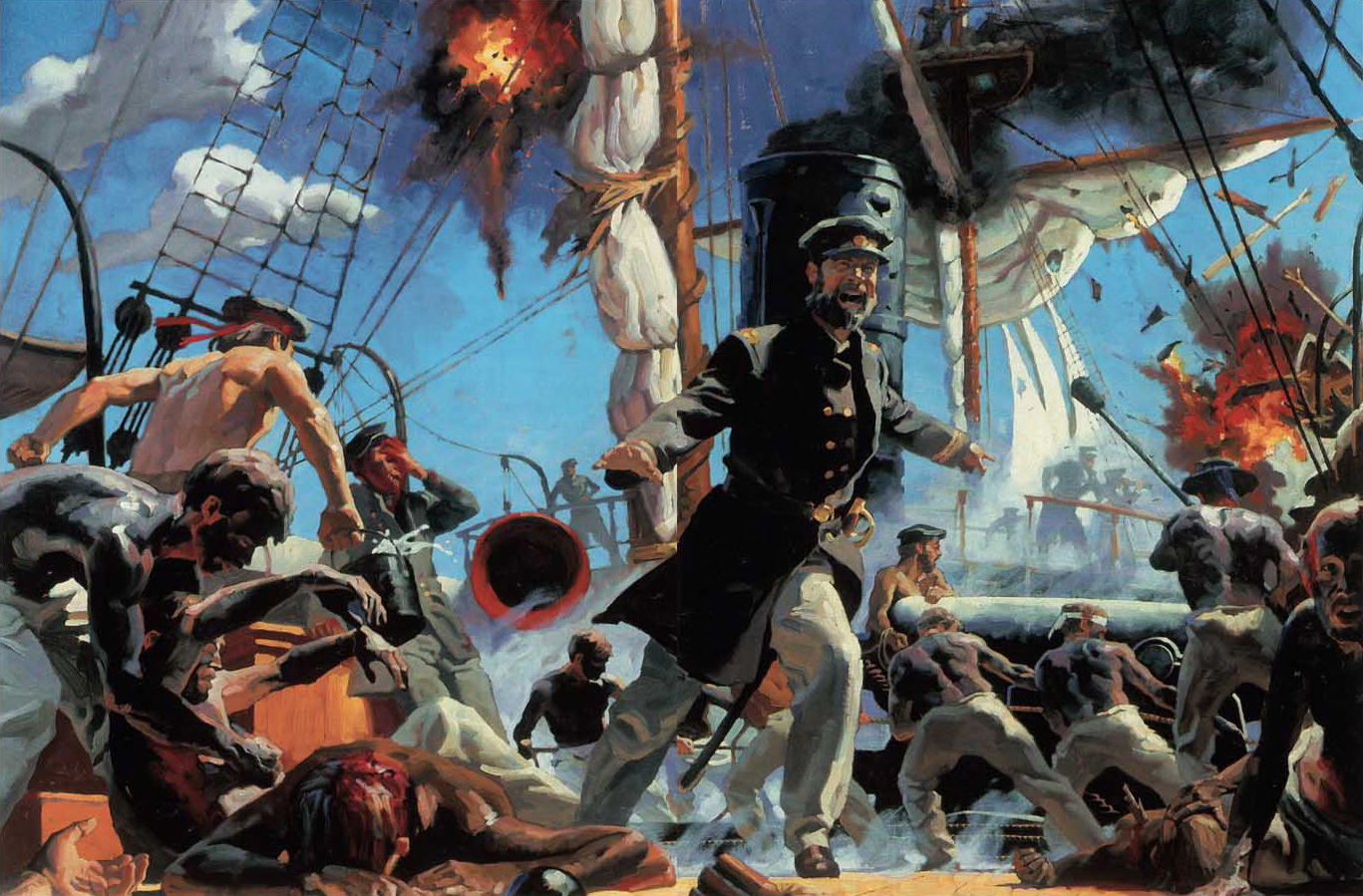
Kell orders a 32-pounder crew to take over the 8-inch Blakely after half its crew is killed. Another too-high shot from the Alabama released the Stars and Stripes to unfurl at the Kearsarge’s mainmast. “The hidden armor of the Kearsarge,” Kell realized later, “prevented the Alabama’s shot from doing serious damage.” For Winslow’s Dahlgrens, the range was practically point-blank, and every hit meant at least an 11-inch hole through the Alabama’s wooden bulwarks, a 133lb shell exploding. “Mr. Thornton!” he ordered. “Aim a trifle more below her waterline.” A Union shell that should have taken the Alabama right in the engine room instead exploded in her packed bunker. For a moment a thick cloud of black coal dust enveloped the deck, but as it blew away aft the crew could see Semmes’ improvised inner armor had worked. They were still in the fight. Alabama, though, was taking on water. The two ships had turned four or five complete circles, firing continuously into each other and drifting all the while on the current to the southwest. The Kearsarge had gradually come around and was threatening to cross Alabama’s stern. Kell called down to the engine room for more steam and was told the boilers would explode if fed any more coal. The 7-inch Blakely, a small gun firing a big shell, had overheated. A shell fragment cut Semmes’ right hand. He is reputed to have offered a reward to anyone who knocked out the Kearsarge’s aft pivot gun. 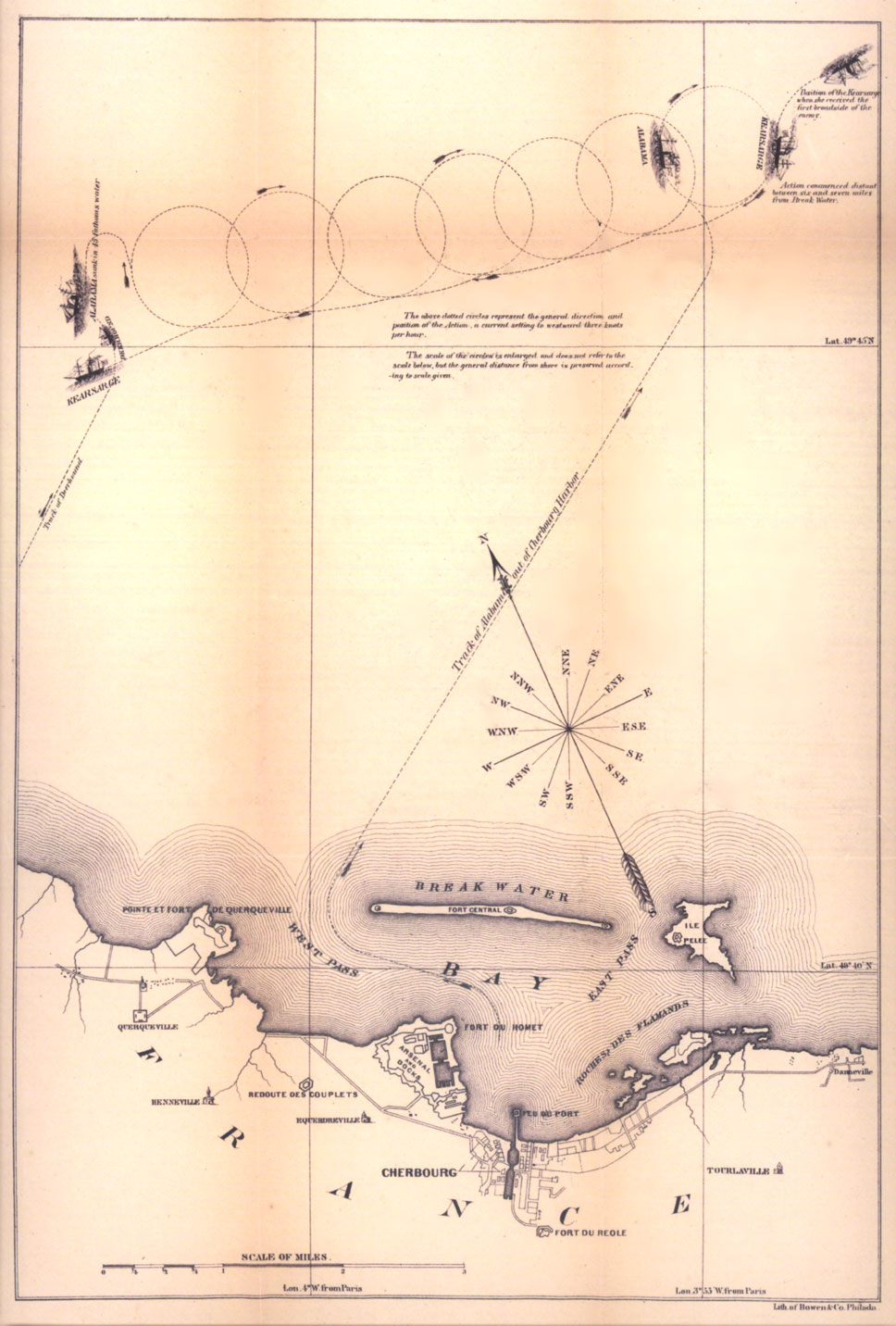
Winslow’s own 1864 map of the battle shows the Alabama’s course from Cherbourg and the ships’ maneuvers. Suddenly the Confederate gun crews, stripped to the waist, streaming sweat and black with powder grime, were doused with seawater and Alabama jolted sideways. An 11-inch shell had entered her below the waterline. It came at the worst moment. Five minutes sooner, or later, and the Alabama would have been pointed toward land. Instead she had begun another circle and was now facing seaward. The Kearsarge, across the circle, was already pointed toward shore, perfectly positioned to cut her off. “For some few minutes I had hopes of being able to reach the French coast,” reported Semmes, “for which purpose I gave the ship all steam, and set such of the fore-and-aft sails as were available.” A shot having smashed her steering gear, the Alabama answered the helm reluctantly. Semmes ordered a jib sail unfurled at the bow to quicken her turn. The forecastle hand who obeyed was, upon exposing himself, immediately disemboweled by a shell fragment. He held his guts in with one hand long enough to release the sail with the other, before falling to the deck dead. The Alabama, sluggish and water-laden, finally managed to come around, only to find the Kearsarge off her port bow, between her and safety. Semmes’s pivot guns were now facing the wrong way; to port he had only the remaining pair of 32-pounders. Winslow, having kept him to starboard the entire time, had a full broadside ready to fire from just 400 yards. He ordered Thornton, “Stand by with the grape.” Endgame. And at this moment a Confederate engineer came up from below to report the rising water had reached Alabama’s furnaces. The ship had lost power. Semmes ordered Kell below to assess the damage. The lieutenant remembered, “The holes in the side of the poor old Alabama were large enough to admit a wheelbarrow.” He rushed back up to tell Semmes she had at most ten minutes left on the surface. “Strike the colors, Mr. Kell,” Semmes told him, “it will not do in the nineteenth century to sacrifice every man we have on board.” 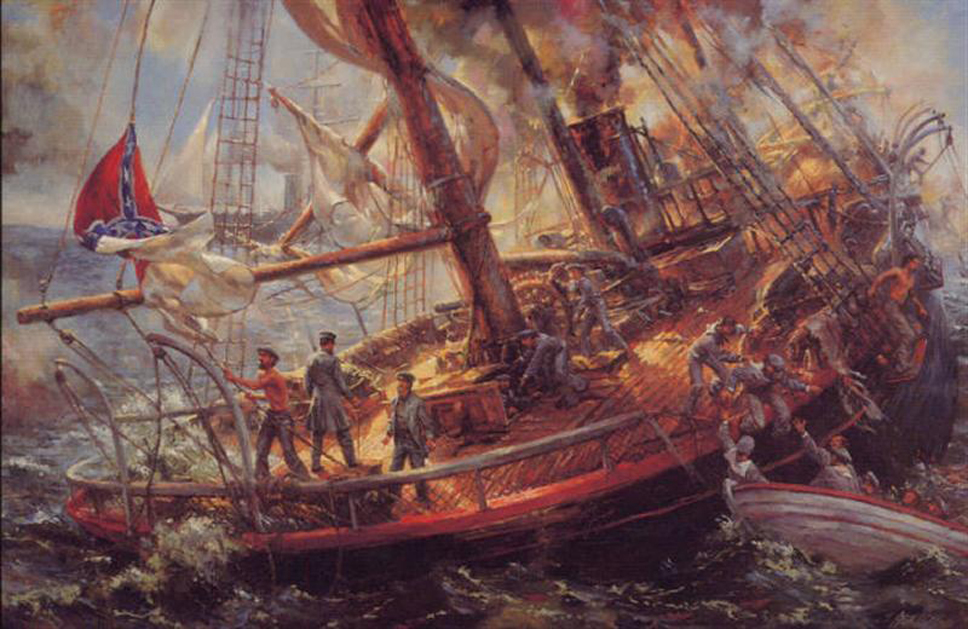
Sinking of the CSS Alabama 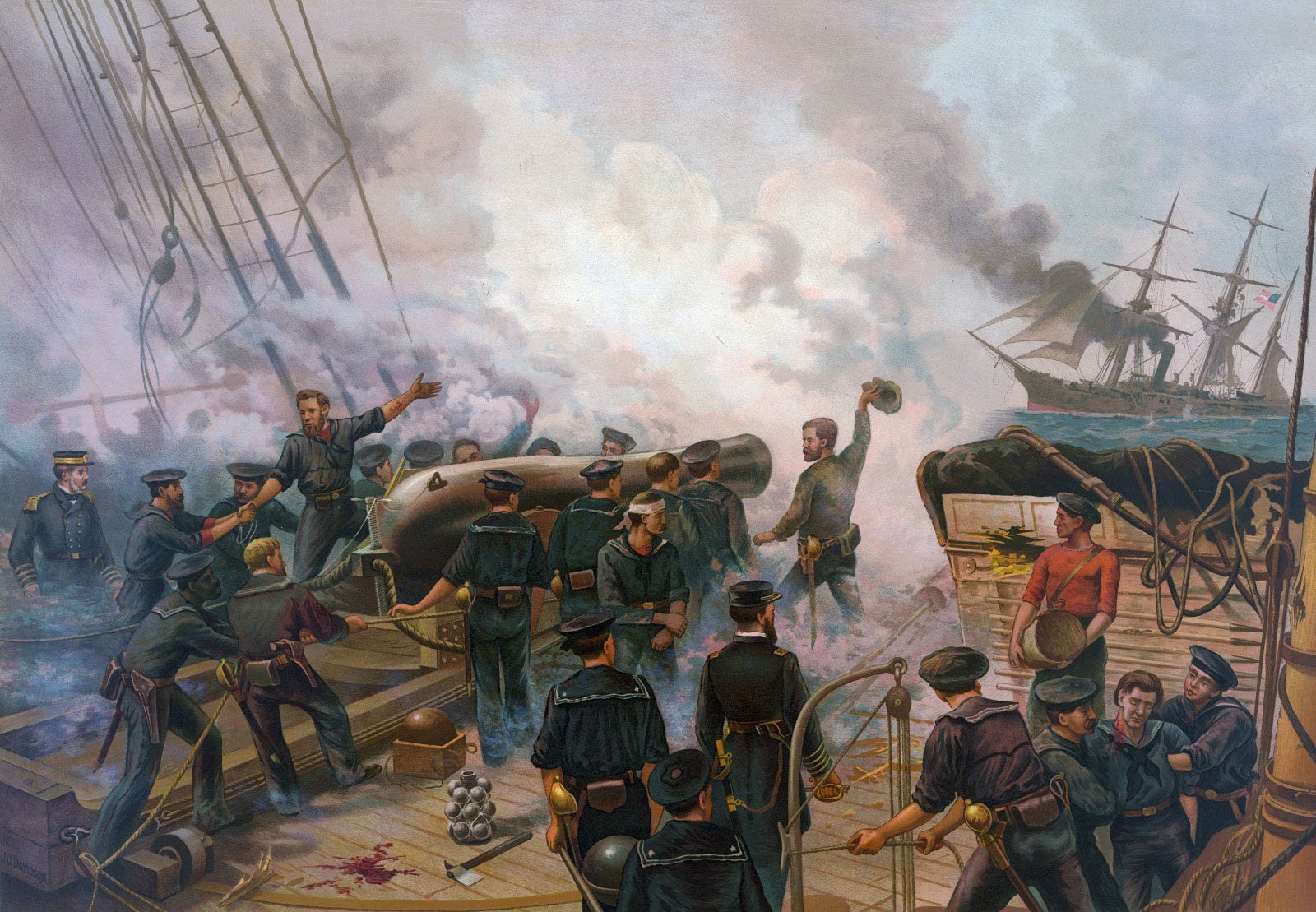
Battle of the USS Kearsarge and the CSS Alabama Even as the Alabama’s flag came down, the Kearsarge hit her with one last broadside. Afterward Winslow insisted the Confederates’ two port-side 32-pounders had opened up on him and, thinking their flag had been shot away again, he merely replied in kind. “It is charitable,” Semmes wrote afterward, “to suppose that a ship of war of a Christian nation could not have done this, intentionally.” He sent a gig boat across to request assistance. Winslow’s lifeboats had all been shot to pieces; it would take the Federals several minutes to unlimber their sailing launch and second cutter, a suspicious delay in the Confederates’ opinion, but Winslow permitted the gig to go back for survivors. Meanwhile the Deerhound, which throughout the battle had remained a mile or so to windward, moved in under the Kearsarge’s stern to offer aid. “Yacht ahoy,” answered the Federals, “lend a hand to save the people.” The French pilot boats joined the rescue. 
Kearsarge and Alabama by Julian O. Davidson (1853-1894) 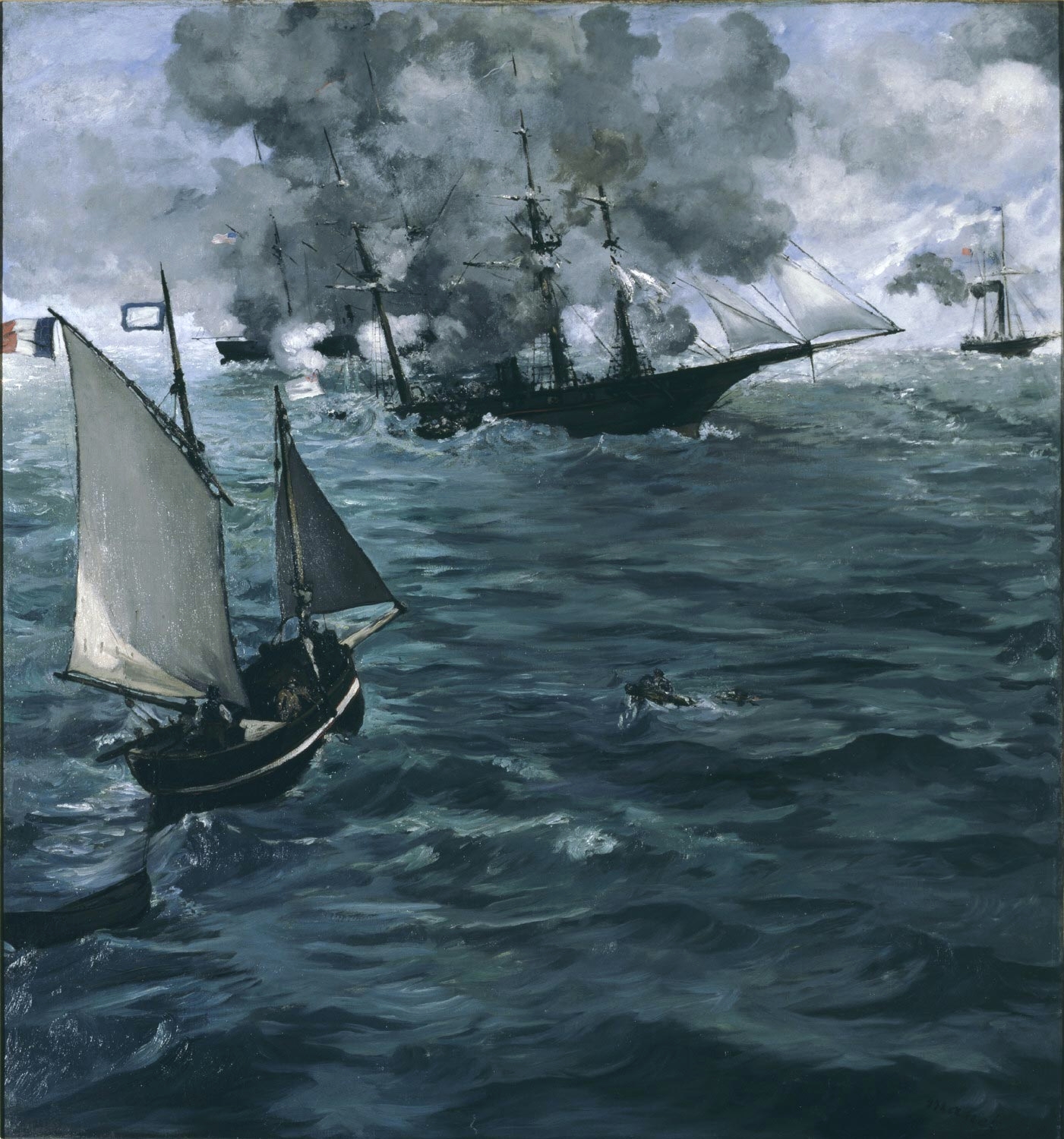
The Battle of the Kearsarge and the Alabama, by Eduard Manet, 1864 By now the Alabama was rapidly settling by the stern. “There was no fear nor hurry-up on the part of the men,” Kell remembered later. “Everything was done quietly, as if the crew were preparing for an ordinary ship inspection.” The officers saw the wounded into the boats, flung their swords into the sea and jumped after them. Shortly before 1:00 PM, about five miles off the Cherbourg breakwater, the CSS Alabama suddenly reared up out of the water. Her bottom showed green with algae and copper patina. Her damaged mainmast snapped from the strain. Then, swiftly, she slid below the surface of the Channel. 26 of her crew died with her, several going down with the ship. “After swimming off a few yards, I turned to see her go down,” remembered Kell. “As the gallant vessel, the most beautiful I ever beheld, plunged down to her grave, I had it on my tongue to call to the men who were struggling in the water to give three cheers for her, but the dead that were floating around me and the deep sadness I felt at parting with the noble ship that had been my home so long deterred me.” 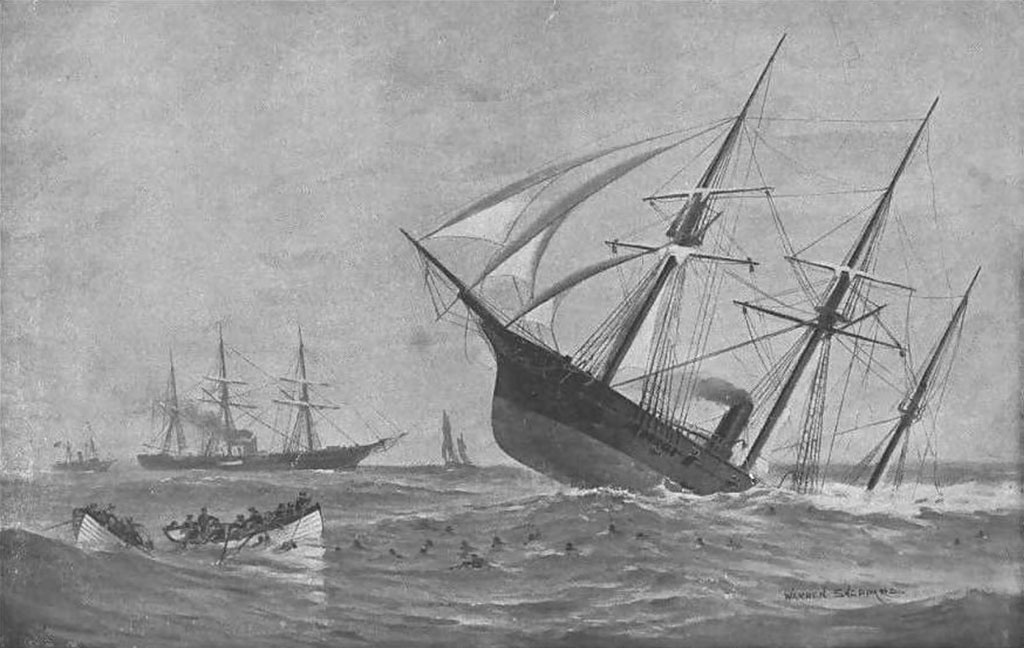
He, Semmes and about forty of the crew managed to reach the Deerhound, where owner Lancaster and his crew took them aboard. Asked where he wanted to go, Semmes requested Southampton, England. Some of Winslow’s officers informed him the Deerhound was making off, but he refused to believe she carried surrendered prisoners of war, let alone Semmes himself. After the Kearsarge put in at Cherbourg, he accused the English yacht of serving as a Confederate tender, in violation of neutrality, setting off an entirely new battle. The United States demanded the return of her rightful prisoners. England, where the Confederates were treated as heroes, refused. After the war, in an international court, Washington filed for “Alabama Claims,” reparations for damages caused by British-built commerce raiders. In arbitration, the US won heavy damages. 
The Alabama Today In late 1984 the French minesweeper Circé, clearing 40-year-old mines, located a sunken ship in the vicinity of the battle. Robot subs and scuba divers revealed it to be the Alabama, lying 180 feet down and about 30 degrees to starboard, partly sheltered by undersea sand dunes. The US, France and England all laid claim, but what had been international waters in 1864 was, 120 years later, within France’s 12-mile limit. Strong tides will prevent the wreck from ever being raised, but today Alabama artifacts can be found on both sides of the Atlantic, including the ship’s bell, the 7-inch Blakely (found with a shell still in the barrel) and several of her 32-pounders. The dud shell embedded in the Kearsarge’s sternpost, which was presented to Pres. Lincoln, now resides at the Washington Navy Yard. 
Alabama’s propeller and lifting frame 
ROV sonar image of the wreck site. 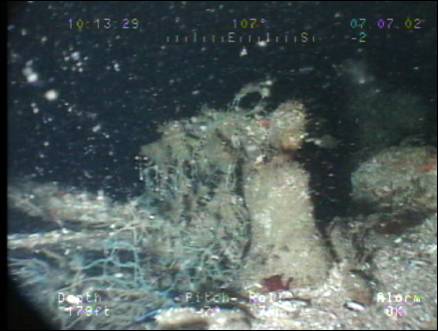
Fishing nets fouled on the wreck 
“She had never had a home within the country she so gallantly served,” Kell said years later of the Alabama, “...No foe men ever trod her deck as victor.” Semmes ran the blockade to return to the Confederacy, was promoted to Rear Admiral and commanded an ironclad in the James River Squadron, but had to destroy his ships to prevent their capture. He even served as a brigadier general in the Confederate Army—the only American officer to hold both ranks simultaneously—but the Rear Admiral and Brigadier General was commanding nothing more than a muddy trench near Danville, VA when word arrived of the surrender at Appomattox. Winslow, his reputation and career revived by his victory over the Alabama, also made rear admiral. He commanded the US Navy’s Pacific Squadron until 1872. Within a year of retiring, he died of a stroke and was buried under a slab of granite from Mt. Kearsarge, NH, for which his ship had been named. (The Kearsarge served, on and off, as a Navy showpiece until she struck a reef in February 1894. She is the only Navy ship named for the mountain; four others have been named after her.) There is no record that he and Semmes ever met again. Not long after the war Semmes (who died in 1877 of food poisoning) wrote of his old friend and greatest adversary, “I had known, and sailed with him, in the old service, and knew him then to be a humane and Christian gentleman. What the war may have made of him, it is impossible to say. It has turned a great deal of the milk of human kindness to gall and wormwood.” 
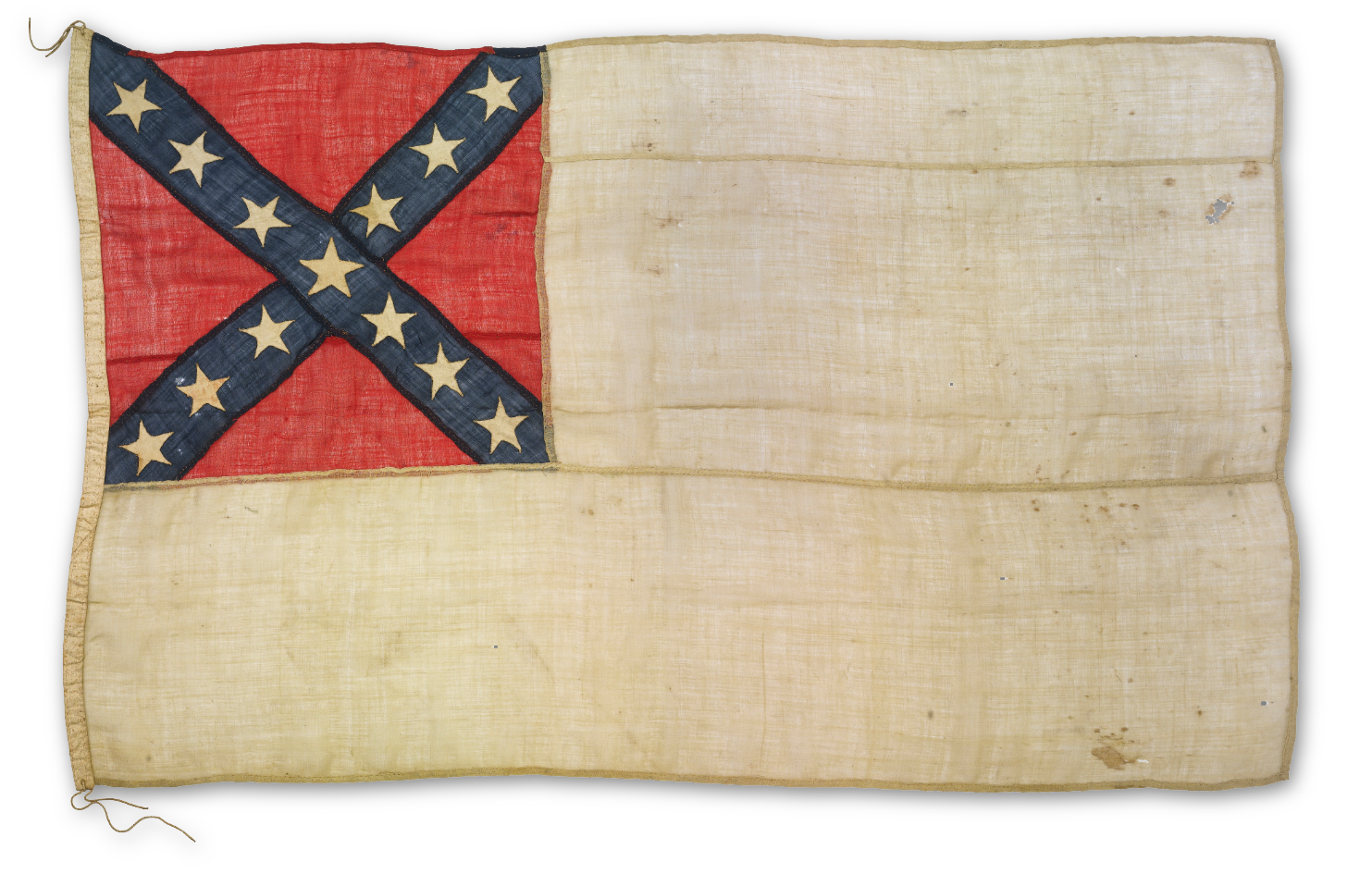
Stainless Banner of CSS Alabama, 39 inches at the hoist by 64 inches at the fly. Sold at Sotheby’s, New York, in 2011 for $218,500 
Bibliography
“290.” Interview by Captain John McIntosh Kell. CSS Alabama Digital Collection. W.S. Hoole Special Collections Library, The University of Alabama. Web. Accessed May 2014. http://www.lib.ua.edu/content/libraries/hoole/digital/cssala/kell2.htm


About the author Don Hollway is an historian, illustrator, historical reenactor and classical rapier fencer. For over twenty-five years his writing on history, aviation and reenacting has appeared in magazines ranging from Aviation History, Excellence, History Magazine, Military Heritage, Military History, Wild West andWorld War II to Muzzleloader, Porsche Panorama, Renaissance Magazine and Scientific American. Many of his articles are available free on his website, donhollway.com, where a number of them rank in the top two or three in global search results. His first nonfiction book, The Last Viking, a gripping history of Norse king Harald Hardrada, is an Amazon best seller in the US and UK, acclaimed by The Times of London and Michael Dirda, Pulitzer Prize-winning critic for The Washington Post. 

More from Don Hollway |
